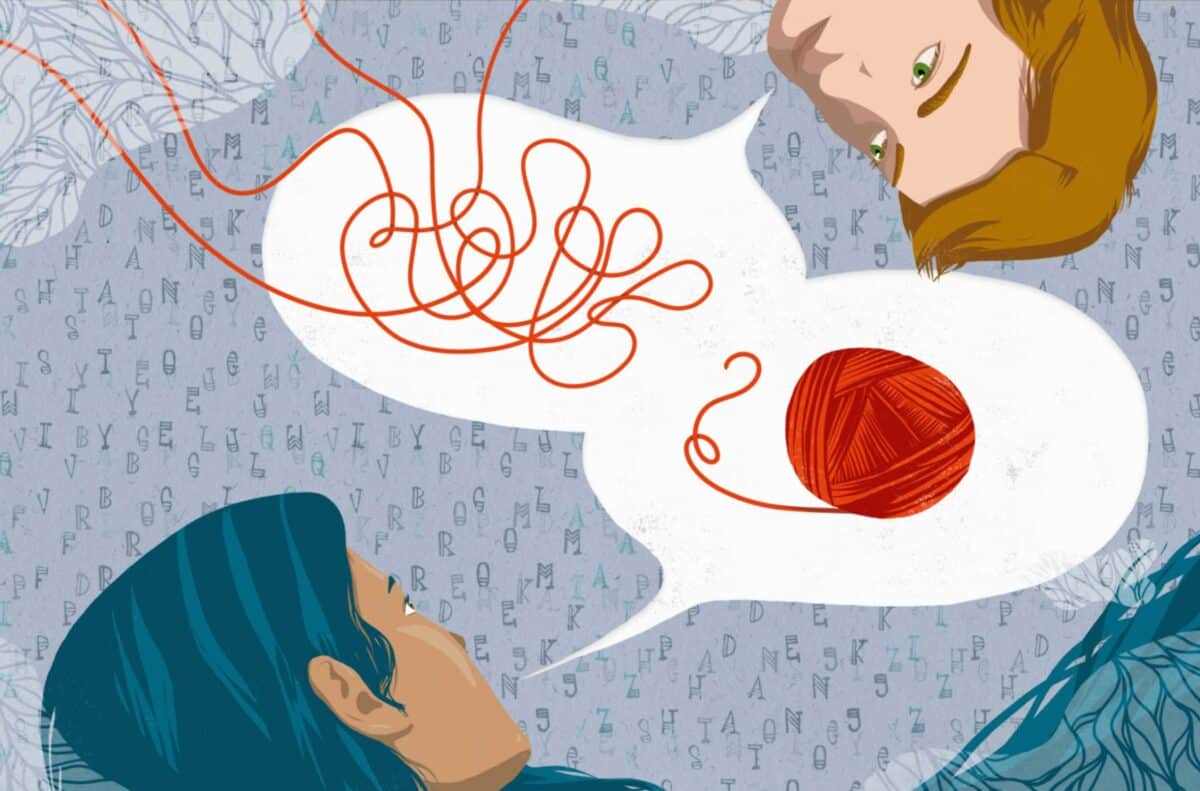The Power of Nonverbal Communication in Public Speaking
- Speaking tips , Presentations , Psychology
Public speaking is more than just the words you say. It’s about how you say them, how you connect with your audience, and the messages you convey through your nonverbal communication.
In this comprehensive guide, we will explore the significance of nonverbal communication , the key elements that make up nonverbal cues, and practical strategies to harness this power to become a more effective and persuasive public speaker .

Table of Contents

The Silent Language
Nonverbal communication, often referred to as “the silent language,” encompasses all the ways we convey information without using words. It’s a potent form of communication because it operates on a subconscious level, influencing how our message is received and interpreted by our audience.
This encompasses a wide range of cues, including:
- Body Language : Your posture, gestures and physical movements.
- Eye Contact : The way you make and maintain eye contact with your audience.
- Proximity : How close or far you are from your audience or other individuals on the stage.
- Appearance : Your clothing, grooming, and overall appearance, which can influence your audience’s perception.
- Use of Space : How you move around the stage or speaking area, including gestures and body positioning. This even includes how you use the frame on camera if you’re speaking online.
- Silence : The pauses and moments of silence in your speech, which can convey meaning and emphasis.
- Facial Expressions: We often have a poker face which does’t do much to enhance the message we’re aiming to convey. Facial expressions that go with the message can amplify your impact.

Photo by Natasha Hall on Unsplash
The Impact of Nonverbal Communication
Nonverbal communication plays a critical role in public speaking for several reasons:
1. Conveys Emotion and Authenticity
Your facial expressions, gestures, and tone of voice allow you to express emotions authentically. When your nonverbal cues align with your message, it adds depth and authenticity to your talk. For example, a smile can convey warmth and approachability, while a furrowed brow may signal concern or seriousness.
2. Enhances Message Clarity
Nonverbal cues can clarify your message, making it easier for your audience to understand and remember. Hand gestures can illustrate key points, and vocal variations can emphasize critical information. These cues act as signposts that guide your audience through your speech.
Pro-tip: if you over-do hand gestures or use repetitive ones, they can be distracting and damage your impact instead of enhancing it.
3. Builds Connection
Effective nonverbal communication helps you establish a strong connection with your audience. Maintaining eye contact, for instance, fosters a sense of engagement and rapport. A speaker who appears confident and approachable through their body language is more likely to connect with the audience .

4. Captures Attention
Engaging nonverbal cues can capture and maintain your audience’s attention. Movement, gestures, and vocal changes can add dynamism to your speech, preventing your audience from becoming disengaged or bored.
In a world where we’re constantly bombarded with notifications and urgent tasks, gaining attention is the real currency.
5. Demonstrates Confidence
Confidence is a quality that every public speaker should exude. Nonverbal cues such as upright posture, steady eye contact, and controlled body movements convey confidence to your audience. When you appear confident, your audience is more likely to trust and respect your message.
Key Elements of Effective Nonverbal Communication
To harness the power of nonverbal communication in public speaking, it’s essential to focus on specific elements and techniques. Let’s explore these key elements:
1. Body Language
Our posture, movements, and gestures are like an open book, revealing our emotions, confidence level, and authenticity. Here’s how body language can enhance or hinder your public speaking:
Posture : Stand or sit upright with your shoulders back. Good posture exudes confidence and presence. Conversely, slouching or crossing your arms can signal insecurity or defensiveness.
Gestures : Use purposeful hand gestures to emphasize points or convey information. Avoid excessive or distracting movements.
Movement : Move purposefully and with intent. Don’t pace nervously, but rather use movement to engage different sections of the audience or transition between points. Moving purposefully and making eye contact with your audience conveys that you’re fully engaged and interested in their response.
Note for speaking online : people often ignore movement and body language when speaking on camera. But in this context, it’s even more important to be more active and confident as the audience receives less information about your presence.
Enhance your on-camera body language by being aware of the frame, using gestures that are within the frame and being intentional with the frequency and variance of your gestures.
Credibility : Avoiding distracting movements, such as fidgeting, pacing excessively or swinging in your chair. This enhances your credibility as a speaker and shows that you’re grounded (literally!).

2. Eye Contact
Maintain Connection : Make eye contact with individuals throughout your audience to create a sense of connection and engagement. This is possible to do online as well – look into the camera instead of looking at yourself or your presentation.
Avoid Staring : Don’t fixate on one person or object for too long, as it can make your audience uncomfortable. Instead, distribute your gaze evenly.
Use of Notes : If using notes or slides, ensure you don’t rely on them excessively. Maintain eye contact while referencing your materials. Pro-tip: Don’t have full sentences on either your slides or your scripts. Have keywords instead and string together the sentences on the spot- this enhances improvisation and makes you sound fresh and natural.

3. Proximity
Your proximity to the audience and your use of personal space can create a sense of intimacy or formality:
Close Proximity: Stepping closer to the audience during a compelling point can create a feeling of closeness and connection.
This works in the online context as well – you’ll notice how the audience reacts when you lean in or when you sit back.
4. Appearance
Dress Appropriately : Your attire should align with the formality and expectations of your audience and the occasion. Dressing well can enhance your credibility.
When in doubt, go a bit more formal vs casual as a rule of thumb.
5. Use of Space
Stage Presence : Occupy the stage with confidence. Move with purpose, and use the space to engage different parts of the audience.
Avoid Excessive Movement : While movement is essential, avoid excessive pacing or aimless wandering, which can distract from your message.

Photo by Igreja Dimensão
Strategic Pauses : Incorporate strategic pauses into your speech to allow your audience to absorb information and emphasize key points.
There is a lot of power in the pause – use it liberally throughout your talk, presentation or podcast.
Control Filler Words : Minimize the use of filler words like “um,” “uh,” or “like.” Silence is preferable to fillers and indicates thoughtfulness.
7. Facial Expressions
Your face is a canvas of emotions, and your audience is keenly observing it. Expressions can either reinforce or contradict your spoken words:
- Smiling : A genuine smile can instantly connect you with your audience and convey warmth and approachability.
- Micro-expressions: You can say a lot with your expressions. Train your face to express emotions intentionally instead of leaving it up to the audience to insert their own emotions.
- Expressive Eyes : Your eyes can express enthusiasm, surprise, or concern, adding depth to your message.

Practical Strategies for Harnessing Nonverbal Communication
Now that we’ve explored the key elements of nonverbal communication, let’s dive into practical strategies for harnessing this power in your public speaking:
1. Practice, Practice, Practice
Effective nonverbal communication requires practice. Rehearse your talk or presentation multiple times, paying attention to your body language, tone of voice, and eye contact. Recording yourself can provide valuable feedback.
2. Audience Analysis
Consider your audience’s expectations, cultural norms, and preferences when it comes to nonverbal cues. Tailor your approach to resonate with your specific audience.
3. Get Feedback
Seek feedback from trusted colleagues, mentors, or speech coaches. They can offer insights into how your nonverbal cues are perceived and provide guidance for improvement.

Nausheen working with top female LinkedIn influencer Lara Acosta , giving feedback on her talk.
4. Use Visualization
Before your talk, visualize yourself delivering it with confidence and impactful nonverbal communication. Visualization can help reduce anxiety and boost your performance.
5. Mindfulness
Stay present and mindful while speaking. Be aware of your nonverbal cues and their alignment with your message. Correct any unintentional cues that may undermine your message.
6. Rehearse Transitions
Pay special attention to transitions in your speech. Smooth transitions with appropriate nonverbal cues can maintain your audience’s engagement and guide them through your message.
7. Record and Review
Record your speeches or presentations whenever possible. Reviewing the footage allows you to identify areas for improvement in your nonverbal communication. Build this as a part of your speaking and practice routine and you’ll grow your speaking skills exponentially.

8. Seek Role Models
Study accomplished public speakers and observe how they use nonverbal communication to enhance their message. Emulate their effective techniques.
Body language is underrated and super powerful as a tool in making you an impactful and memorable speaker.
Great non verbal communication can elevate your message and captivate your audience.
By mastering the key elements of body language , tone of voice, eye contact, appearance, use of space, and silence, and by implementing practical strategies for improvement, you can become a more effective and persuasive speaker.
Remember that nonverbal communication is not just an afterthought – it’s an integral part of the message itself. Embrace this power, and you’ll find that your impact as a public speaker transcends the spoken word alone.
If you want to work with an amazing coach who can guide you through this process of overcoming your stage fright , might I recommend myself? Find out how you can work with me and take advantage of my 10,000+ hours on stage and on camera to become a better speaker.

Nausheen I. Chen
Get a free 5-day course in speaking fearlessly, you might also like.
- Confidence , On camera , Speaking tips
Public Speaking: “How to Speak with Impact” with Kim Kaupe on Coffee with Kim podcast
- Speaking tips
Choosing a Public Speaking Coach: What Most People Overlook
- public speaking , TED Talk
Unveiling the TED Talk Process: What You Don’t Know Yet
- Confidence , public speaking , Speaking tips
How to Make People Listen When You Speak: 5 Techniques You Haven’t Tried Yet
- Confidence , Psychology , public speaking , Speaking tips
The Best Mindset for Public Speaking: Why It’s Not What You Think
- fear of public speaking , public speaking
74% of People Fear Public Speaking: Here’s How to Beat Glossophobia
Videos you might like, speak like a ted talk speaker: 5 powerful techniques, public speaking courses 101: how to choose the best course for your needs, “hello” 5 powerful strategies to introduce yourself in any presentation, public speaking tips: 6 powerful tips to influence people, how to create unforgettable videos as an entrepreneur, how to start your first podcast, build an amazing brand, and make money with podcasting.
Transform your speaking skills in 5 days. Sign up to find out how to turn your words into powerful, confident communication. This free video course will give you concrete strategies to gain more confidence and speak fearlessly at your next presentation, meeting or podcast.
By clicking the button above, you are agreeing to the terms outlined in our privacy policy .

Work With Me
Free resources, privacy & transparency.
- Privacy Policy
- Cookie Policy
© 2023 Nausheen I. Chen. All rights reserved.

August 22nd @ 12 PM EST / 4 PM GMT
Level up your speaking skills to attract more clients and close more deals.
Click here for more details about this free masterclass.
Delivering your speech: the power of nonverbal communication
When I say “public speaking” what comes to mind? Dread? Nervousness? Excitement? “Public speaking” often brings uneasy feelings to first year students, as standing in front of a classroom ranging from first year to fourth years may seem a lot more intimidating than one full of your long-time high school classmates. You have a well-written and researched speech and you have already sought out a peer review from the Writing and Communication Centre, but the easy part is over. Delivering your speech involves more than a professional tone and a confident voice; you will convey the real impact of your message through nonverbal communication. Nonverbal communication is the communication we engage in that isn’t written or spoken language, but still creates meaning.
Eye contact, one of the most important nonverbal cues, keeps your audience engaged, makes you believable, and opens up communication. Looking at individual members of the audience establishes an interpersonal connection with them. While maintaining eye contact is important, gestures are useful when emphasizing certain points. Gestures are an excellent way to channel your nerves into movement, as long as you ensure they are not repetitive or taking away from your message. Using immediacy behaviours, that is, literally or psychologically making your audience members feel closer to you, can establish more relationships as a speaker. Moving closer to your audience or smiling are simple ways to create a closer relationship between you and your listeners.
The audience sees your face before they are going to hear your voice and thus, you have the opportunity to set an emotional tone before you even start speaking. As a speaker, you can decide how your facial expression can alter the atmosphere of your speech in a meaningful way. In many instances, audience members will mimic your emotions, so if you want your audience to feel a certain emotion, its best to express that emotion yourself. Although your face and voice play a major role in communicating a specific emotion, your posture will communicate the intensity of that emotion.
You might be overwhelmed at the long list of unconscious habits to consider when delivering a speech. Delivering a hard hitting, persuasive or informative speech is not easy, but it is an important and useful skill for your post-secondary education and beyond. If you need ideas, feedback, or strategies in creating and delivering a speech, the Writing and Communication Centre is a hub for practice, development and collaboration that can work with you to help develop your individual voice in your academic work. With practice, knowledge and a bit of help, public speaking does not have to be a daunting task, but an opportunity to share your ideas and leave a memorable impression as a speaker.
- communication ,
- public speaking ,
- nonverbal communication ,
- Writing and Communication Centre ,
- Current students ,
- Current undergraduate students ,
- Current graduate students ,
- Future students ,
- Future undergraduate students

Want to create or adapt books like this? Learn more about how Pressbooks supports open publishing practices.
4.1 Principles and Functions of Nonverbal Communication
Learning objectives.
- Define nonverbal communication.
- Compare and contrast verbal communication and nonverbal communication.
- Discuss the principles of nonverbal communication.
- Provide examples of the functions of nonverbal communication.
As you’ll recall from our introductory chapter, a channel is the sensory route on which a message travels. Oral communication only relies on one channel, because spoken language is transmitted through sound and picked up by our ears. Nonverbal communication, on the other hand, can be taken in by all five of our senses. Since most of our communication relies on visual and auditory channels, those will be the focus of this chapter. But we can also receive messages and generate meaning through touch, taste, and smell. Touch is an especially powerful form of nonverbal communication that we will discuss in this chapter, but we will not get into taste and smell, which have not received as much scholarly attention in relation to nonverbal communication as the other senses.
To further define nonverbal communication, we need to distinguish between vocal and verbal aspects of communication. Verbal and nonverbal communication include both vocal and nonvocal elements, and Table 4.1 “Vocal and Nonvocal Elements of Communication” shows the relationship among vocal, nonvocal, verbal, and nonverbal aspects of communication. A vocal element of verbal communication is spoken words—for example, “Come back here.” A vocal element of nonverbal communication is paralanguage , which is the vocalized but not verbal part of a spoken message, such as speaking rate, volume, and pitch. Nonvocal elements of verbal communication include the use of unspoken symbols to convey meaning. Writing and American Sign Language (ASL) are nonvocal examples of verbal communication and are not considered nonverbal communication. Nonvocal elements of nonverbal communication include body language such as gestures, facial expressions, and eye contact. Gestures are nonvocal and nonverbal since most of them do not refer to a specific word like a written or signed symbol does.
Table 4.1 Vocal and Nonvocal Elements of Communication
| Verbal Communication | Nonverbal Communication | |
|---|---|---|
| Vocal | Spoken words | Paralanguage (pitch, volume, speaking rate, etc.) |
| Nonvocal | Writing, sign language | Body language (gestures, facial expressions, eye contact, etc.) |
Source: Adapted from Owen Hargie, Skilled Interpersonal Interaction: Research, Theory, and Practice (London: Routledge, 2011), 45.
Principles of Nonverbal Communication
Nonverbal communication has a distinct history and serves separate evolutionary functions from verbal communication. For example, nonverbal communication is primarily biologically based while verbal communication is primarily culturally based. This is evidenced by the fact that some nonverbal communication has the same meaning across cultures while no verbal communication systems share that same universal recognizability (Andersen, 1999). Nonverbal communication also evolved earlier than verbal communication and served an early and important survival function that helped humans later develop verbal communication. While some of our nonverbal communication abilities, like our sense of smell, lost strength as our verbal capacities increased, other abilities like paralanguage and movement have grown alongside verbal complexity. The fact that nonverbal communication is processed by an older part of our brain makes it more instinctual and involuntary than verbal communication.
Nonverbal Communication Conveys Important Interpersonal and Emotional Messages
You’ve probably heard that more meaning is generated from nonverbal communication than from verbal. Some studies have claimed that 90 percent of our meaning is derived from nonverbal signals, but more recent and reliable findings claim that it is closer to 65 percent (Guerrero & Floyd, 2006). We may rely more on nonverbal signals in situations where verbal and nonverbal messages conflict and in situations where emotional or relational communication is taking place (Hargie, 2011). For example, when someone asks a question and we’re not sure about the “angle” they are taking, we may hone in on nonverbal cues to fill in the meaning. For example, the question “What are you doing tonight?” could mean any number of things, but we could rely on posture, tone of voice, and eye contact to see if the person is just curious, suspicious, or hinting that they would like company for the evening. We also put more weight on nonverbal communication when determining a person’s credibility. For example, if a classmate delivers a speech in class and her verbal content seems well-researched and unbiased, but her nonverbal communication is poor (her voice is monotone, she avoids eye contact, she fidgets), she will likely not be viewed as credible. Conversely, in some situations, verbal communication might carry more meaning than nonverbal. In interactions where information exchange is the focus, at a briefing at work, for example, verbal communication likely accounts for much more of the meaning generated. Despite this exception, a key principle of nonverbal communication is that it often takes on more meaning in interpersonal and/or emotional exchanges.

About 65 percent of the meaning we derive during interactions comes from nonverbal communication.
Gideon – In Perfect Congruence – CC BY 2.0.
Nonverbal Communication Is More Involuntary than Verbal
There are some instances in which we verbally communicate involuntarily. These types of exclamations are often verbal responses to a surprising stimulus. For example, we say “owww!” when we stub our toe or scream “stop!” when we see someone heading toward danger. Involuntary nonverbal signals are much more common, and although most nonverbal communication isn’t completely involuntary, it is more below our consciousness than verbal communication and therefore more difficult to control.
The involuntary nature of much nonverbal communication makes it more difficult to control or “fake.” For example, although you can consciously smile a little and shake hands with someone when you first see them, it’s difficult to fake that you’re “happy” to meet someone. Nonverbal communication leaks out in ways that expose our underlying thoughts or feelings. Spokespeople, lawyers, or other public representatives who are the “face” of a politician, celebrity, corporation, or organization must learn to control their facial expressions and other nonverbal communication so they can effectively convey the message of their employer or client without having their personal thoughts and feelings leak through. Poker players, therapists, police officers, doctors, teachers, and actors are also in professions that often require them to have more awareness of and control over their nonverbal communication.
Have you ever tried to conceal your surprise, suppress your anger, or act joyful even when you weren’t? Most people whose careers don’t involve conscious manipulation of nonverbal signals find it difficult to control or suppress them. While we can consciously decide to stop sending verbal messages, our nonverbal communication always has the potential of generating meaning for another person. The teenager who decides to shut out his dad and not communicate with him still sends a message with his “blank” stare (still a facial expression) and lack of movement (still a gesture). In this sense, nonverbal communication is “irrepressible” (Andersen, 1999).
Nonverbal Communication Is More Ambiguous
In Chapter 3 “Verbal Communication” , we learn that the symbolic and abstract nature of language can lead to misunderstandings, but nonverbal communication is even more ambiguous. As with verbal communication, most of our nonverbal signals can be linked to multiple meanings, but unlike words, many nonverbal signals do not have any one specific meaning. If you’ve ever had someone wink at you and didn’t know why, you’ve probably experienced this uncertainty. Did they wink to express their affection for you, their pleasure with something you just did, or because you share some inside knowledge or joke?
Just as we look at context clues in a sentence or paragraph to derive meaning from a particular word, we can look for context clues in various sources of information like the physical environment, other nonverbal signals, or verbal communication to make sense of a particular nonverbal cue. Unlike verbal communication, however, nonverbal communication doesn’t have explicit rules of grammar that bring structure, order, and agreed-on patterns of usage. Instead, we implicitly learn norms of nonverbal communication, which leads to greater variance. In general, we exhibit more idiosyncrasies in our usage of nonverbal communication than we do with verbal communication, which also increases the ambiguity of nonverbal communication.
Nonverbal Communication Is More Credible
Although we can rely on verbal communication to fill in the blanks sometimes left by nonverbal expressions, we often put more trust into what people do over what they say. This is especially true in times of stress or danger when our behaviors become more instinctual and we rely on older systems of thinking and acting that evolved before our ability to speak and write (Andersen, 1999). This innateness creates intuitive feelings about the genuineness of nonverbal communication, and this genuineness relates back to our earlier discussion about the sometimes involuntary and often subconscious nature of nonverbal communication. An example of the innateness of nonverbal signals can be found in children who have been blind since birth but still exhibit the same facial expressions as other children. In short, the involuntary or subconscious nature of nonverbal communication makes it less easy to fake, which makes it seem more honest and credible. We will learn more about the role that nonverbal communication plays in deception later in this chapter.
Functions of Nonverbal Communication
A primary function of nonverbal communication is to convey meaning by reinforcing, substituting for, or contradicting verbal communication. Nonverbal communication is also used to influence others and regulate conversational flow. Perhaps even more important are the ways in which nonverbal communication functions as a central part of relational communication and identity expression.
Nonverbal Communication Conveys Meaning
Nonverbal communication conveys meaning by reinforcing, substituting for, or contradicting verbal communication. As we’ve already learned, verbal and nonverbal communication are two parts of the same system that often work side by side, helping us generate meaning. In terms of reinforcing verbal communication, gestures can help describe a space or shape that another person is unfamiliar with in ways that words alone cannot. Gestures also reinforce basic meaning—for example, pointing to the door when you tell someone to leave. Facial expressions reinforce the emotional states we convey through verbal communication. For example, smiling while telling a funny story better conveys your emotions (Hargie, 2011). Vocal variation can help us emphasize a particular part of a message, which helps reinforce a word or sentence’s meaning. For example, saying “How was your weekend?” conveys a different meaning than “How was your weekend ?”
Nonverbal communication can substitute for verbal communication in a variety of ways. Nonverbal communication can convey much meaning when verbal communication isn’t effective because of language barriers. Language barriers are present when a person hasn’t yet learned to speak or loses the ability to speak. For example, babies who have not yet developed language skills make facial expressions, at a few months old, that are similar to those of adults and therefore can generate meaning (Oster, Hegley, & Nagel, 1992). People who have developed language skills but can’t use them because they have temporarily or permanently lost them or because they are using incompatible language codes, like in some cross-cultural encounters, can still communicate nonverbally. Although it’s always a good idea to learn some of the local language when you travel, gestures such as pointing or demonstrating the size or shape of something may suffice in basic interactions.
Nonverbal communication is also useful in a quiet situation where verbal communication would be disturbing; for example, you may use a gesture to signal to a friend that you’re ready to leave the library. Crowded or loud places can also impede verbal communication and lead people to rely more on nonverbal messages. Getting a server or bartender’s attention with a hand gesture is definitely more polite than yelling, “Hey you!” Finally, there are just times when we know it’s better not to say something aloud. If you want to point out a person’s unusual outfit or signal to a friend that you think his or her date is a loser, you’re probably more likely to do that nonverbally.
Last, nonverbal communication can convey meaning by contradicting verbal communication. As we learned earlier, we often perceive nonverbal communication to be more credible than verbal communication. This is especially true when we receive mixed messages , or messages in which verbal and nonverbal signals contradict each other. For example, a person may say, “You can’t do anything right!” in a mean tone but follow that up with a wink, which could indicate the person is teasing or joking. Mixed messages lead to uncertainty and confusion on the part of receivers, which leads us to look for more information to try to determine which message is more credible. If we are unable to resolve the discrepancy, we are likely to react negatively and potentially withdraw from the interaction (Hargie, 2011). Persistent mixed messages can lead to relational distress and hurt a person’s credibility in professional settings.

We send mixed messages when our verbal and nonverbal communication contradict each other. If this woman said she was excited about seeing you, would you believe her?
Helena Peixoto – bored – CC BY-NC 2.0.
Nonverbal Communication Influences Others
Nonverbal communication can be used to influence people in a variety of ways, but the most common way is through deception. Deception is typically thought of as the intentional act of altering information to influence another person, which means that it extends beyond lying to include concealing, omitting, or exaggerating information. While verbal communication is to blame for the content of the deception, nonverbal communication partners with the language through deceptive acts to be more convincing. Since most of us intuitively believe that nonverbal communication is more credible than verbal communication, we often intentionally try to control our nonverbal communication when we are engaging in deception. Likewise, we try to evaluate other people’s nonverbal communication to determine the veracity of their messages. Students initially seem surprised when we discuss the prevalence of deception, but their surprise diminishes once they realize that deception isn’t always malevolent, mean, or hurtful. Deception obviously has negative connotations, but people engage in deception for many reasons, including to excuse our own mistakes, to be polite to others, or to influence others’ behaviors or perceptions.
The fact that deception served an important evolutionary purpose helps explain its prevalence among humans today. Species that are capable of deception have a higher survival rate. Other animals engage in nonverbal deception that helps them attract mates, hide from predators, and trap prey (Andersen, 1999). To put it bluntly, the better at deception a creature is, the more likely it is to survive. So, over time, the humans that were better liars were the ones that got their genes passed on. But the fact that lying played a part in our survival as a species doesn’t give us a license to lie.
Aside from deception, we can use nonverbal communication to “take the edge off” a critical or unpleasant message in an attempt to influence the reaction of the other person. We can also use eye contact and proximity to get someone to move or leave an area. For example, hungry diners waiting to snag a first-come-first-serve table in a crowded restaurant send messages to the people who have already eaten and paid that it’s time to go. People on competition reality television shows like Survivor and Big Brother play what they’ve come to term a “social game.” The social aspects of the game involve the manipulation of verbal and nonverbal cues to send strategic messages about oneself in an attempt to influence others. Nonverbal cues such as length of conversational turn, volume, posture, touch, eye contact, and choices of clothing and accessories can become part of a player’s social game strategy. Although reality television isn’t a reflection of real life, people still engage in competition and strategically change their communication to influence others, making it important to be aware of how we nonverbally influence others and how they may try to influence us.
Nonverbal Communication Regulates Conversational Flow
Conversational interaction has been likened to a dance, where each person has to make moves and take turns without stepping on the other’s toes. Nonverbal communication helps us regulate our conversations so we don’t end up constantly interrupting each other or waiting in awkward silences between speaker turns. Pitch, which is a part of vocalics, helps us cue others into our conversational intentions. A rising pitch typically indicates a question and a falling pitch indicates the end of a thought or the end of a conversational turn. We can also use a falling pitch to indicate closure, which can be very useful at the end of a speech to signal to the audience that you are finished, which cues the applause and prevents an awkward silence that the speaker ends up filling with “That’s it” or “Thank you.” We also signal our turn is coming to an end by stopping hand gestures and shifting our eye contact to the person who we think will speak next (Hargie, 2011). Conversely, we can “hold the floor” with nonverbal signals even when we’re not exactly sure what we’re going to say next. Repeating a hand gesture or using one or more verbal fillers can extend our turn even though we are not verbally communicating at the moment.
Nonverbal Communication Affects Relationships
To successfully relate to other people, we must possess some skill at encoding and decoding nonverbal communication. The nonverbal messages we send and receive influence our relationships in positive and negative ways and can work to bring people together or push them apart. Nonverbal communication in the form of tie signs, immediacy behaviors, and expressions of emotion are just three of many examples that illustrate how nonverbal communication affects our relationships.
Tie signs are nonverbal cues that communicate intimacy and signal the connection between two people. These relational indicators can be objects such as wedding rings or tattoos that are symbolic of another person or the relationship, actions such as sharing the same drinking glass, or touch behaviors such as hand-holding (Afifi & Johnson, 2005). Touch behaviors are the most frequently studied tie signs and can communicate much about a relationship based on the area being touched, the length of time, and the intensity of the touch. Kisses and hugs, for example, are considered tie signs, but a kiss on the cheek is different from a kiss on the mouth and a full embrace is different from a half embrace. If you consider yourself a “people watcher,” take note of the various tie signs you see people use and what they might say about the relationship.
Immediacy behaviors play a central role in bringing people together and have been identified by some scholars as the most important function of nonverbal communication (Andersen & Andersen, 2005). Immediacy behaviors are verbal and nonverbal behaviors that lessen real or perceived physical and psychological distance between communicators and include things like smiling, nodding, making eye contact, and occasionally engaging in social, polite, or professional touch (Comadena, Hunt, & Simonds, 2007). Immediacy behaviors are a good way of creating rapport, or a friendly and positive connection between people. Skilled nonverbal communicators are more likely to be able to create rapport with others due to attention-getting expressiveness, warm initial greetings, and an ability to get “in tune” with others, which conveys empathy (Riggio, 1992). These skills are important to help initiate and maintain relationships.
While verbal communication is our primary tool for solving problems and providing detailed instructions, nonverbal communication is our primary tool for communicating emotions. This makes sense when we remember that nonverbal communication emerged before verbal communication and was the channel through which we expressed anger, fear, and love for thousands of years of human history (Andersen, 1999). Touch and facial expressions are two primary ways we express emotions nonverbally. Love is a primary emotion that we express nonverbally and that forms the basis of our close relationships. Although no single facial expression for love has been identified, it is expressed through prolonged eye contact, close interpersonal distances, increased touch, and increased time spent together, among other things. Given many people’s limited emotional vocabulary, nonverbal expressions of emotion are central to our relationships.
“Getting Real”
Teachers and Immediacy Behaviors
A considerable amount of research has been done on teachers’ use of immediacy behaviors, which points to the importance of this communication concept in teaching professions (Richmond, Lane, & McCroskey, 2006). Immediacy behaviors are verbal and nonverbal behaviors that lessen real or perceived physical and psychological distance between communicators (Comadena, Hunt, & Simonds, 2007). Specific nonverbal behaviors have been found to increase or decrease perceived levels of immediacy, and such behaviors impact student learning, teacher’s evaluations, and the teacher-student relationship (Richmond, Lane, & McCroskey, 2006). Even those who do not plan on going into teaching as a career can benefit from learning about immediacy behaviors, as they can also be used productively in other interpersonal contexts such as between a manager and employee, a salesperson and a client, or a politician and constituent. Much of this research in teaching contexts has focused on the relationship between immediacy behaviors and student learning, and research consistently shows that effective use of immediacy behaviors increases learning in various contexts and at various levels. Aside from enhancing student learning, the effective use of immediacy behaviors also leads to better evaluations by students, which can have a direct impact on a teacher’s career. While student evaluations of teachers take various factors into consideration, judgments of personality may be formed, as we learned in Chapter 2 “Communication and Perception” , after only brief initial impressions. Research shows that students make character assumptions about teachers after only brief exposure to their nonverbal behaviors. Based on nonverbal cues such as frowning, head nodding, pointing, sitting, smiling, standing, strong gestures, weak gestures, and walking, students may or may not evaluate a teacher as open, attentive, confident, dominant, honest, likable, anxious, professional, supportive, or enthusiastic. The following are examples of immediacy behaviors that can be effectively used by teachers:
- Moving around the classroom during class activities, lectures, and discussions (reduces physical distance)
- Keeping the line of sight open between the teacher’s body and the students by avoiding or only briefly standing behind lecterns / computer tables or sitting behind a desk while directly interacting with students (reduces physical distance)
- Being expressive and animated with facial expressions, gestures, and voice (demonstrates enthusiasm)
- Smiling (creates a positive and open climate)
- Making frequent eye contact with students (communicates attentiveness and interest)
- Calling students by name (reduces perceived psychological distance)
- Making appropriate self-disclosures to students about personal thoughts, feelings, or experiences (reduces perceived psychological distance, creates open climate)
Teachers who are judged as less immediate are more likely to sit, touch their heads, shake instead of nod their heads, use sarcasm, avoid eye contact, and use less expressive nonverbal behaviors. Finally, immediacy behaviors affect the teacher-student relationship. Immediacy behaviors help establish rapport, which is a personal connection that increases students’ investment in the class and material, increases motivation, increases communication between teacher and student, increases liking, creates a sense of mutual respect, reduces challenging behavior by students, and reduces anxiety.
- Recall a teacher you have had that exhibited effective immediacy behaviors. Recall a teacher you have had that didn’t exhibit immediacy behaviors. Make a column for each teacher and note examples of specific behaviors of each. Discuss your list with a classmate and compare and contrast your lists.
- Think about the teachers that you listed in the previous question. Discuss how their behaviors affected your learning and your relationship.
- How much should immediacy behaviors, relative to other characteristics such as professionalism, experience, training, and content knowledge, factor into the evaluation of teachers by their students, peers, and supervisors? What, if anything, should schools do to enhance teachers’ knowledge of immediacy behaviors?
Nonverbal Communication Expresses Our Identities
Nonverbal communication expresses who we are. Our identities (the groups to which we belong, our cultures, our hobbies and interests, etc.) are conveyed nonverbally through the way we set up our living and working spaces, the clothes we wear, the way we carry ourselves, and the accents and tones of our voices. Our physical bodies give others impressions about who we are, and some of these features are more under our control than others. Height, for example, has been shown to influence how people are treated and perceived in various contexts. Our level of attractiveness also influences our identities and how people perceive us. Although we can temporarily alter our height or looks—for example, with different shoes or different color contact lenses—we can only permanently alter these features using more invasive and costly measures such as cosmetic surgery. We have more control over some other aspects of nonverbal communication in terms of how we communicate our identities. For example, the way we carry and present ourselves through posture, eye contact, and tone of voice can be altered to present ourselves as warm or distant depending on the context.
Aside from our physical body, artifacts , which are the objects and possessions that surround us, also communicate our identities. Examples of artifacts include our clothes, jewelry, and space decorations. In all the previous examples, implicit norms or explicit rules can affect how we nonverbally present ourselves. For example, in a particular workplace it may be a norm (implicit) for people in management positions to dress casually, or it may be a rule (explicit) that different levels of employees wear different uniforms or follow particular dress codes. We can also use nonverbal communication to express identity characteristics that do not match up with who we actually think we are. Through changes to nonverbal signals, a capable person can try to appear helpless, a guilty person can try to appear innocent, or an uninformed person can try to appear credible.
Key Takeaways
- Nonverbal communication is a process of generating meaning using behavior other than words. Nonverbal communication includes vocal elements, which is referred to as paralanguage and includes pitch, volume, and rate, and nonvocal elements, which are usually referred to as body language and includes gestures, facial expressions, and eye contact, among other things.
- Although verbal communication and nonverbal communication work side by side as part of a larger language system, there are some important differences between the two. They are processed by different hemispheres of the brain, nonverbal communication conveys more emotional and affective meaning than does verbal communication, nonverbal communication isn’t governed by an explicit system of rules in the same way that grammar guides verbal communication, and while verbal communication is a uniquely human ability, many creatures including plants, birds, and mammals communicate nonverbally.
- Nonverbal communication operates on the following principles: nonverbal communication typically conveys more meaning than verbal communication, nonverbal communication is more involuntary than verbal communication, nonverbal communication is often more ambiguous than verbal communication, and nonverbal communication is often more credible than verbal communication.
- Nonverbal communication serves several functions.
- Nonverbal communication affects verbal communication in that it can complement, reinforce, substitute, or contradict verbal messages.
- Nonverbal communication influences others, as it is a key component of deception and can be used to assert dominance or to engage in compliance gaining.
- Nonverbal communication regulates conversational flow, as it provides important cues that signal the beginning and end of conversational turns and facilitates the beginning and end of an interaction.
- Nonverbal communication affects relationships, as it is a primary means through which we communicate emotions, establish social bonds, and engage in relational maintenance.
- Nonverbal communication expresses our identities, as who we are is conveyed through the way we set up our living and working spaces, the clothes we wear, our personal presentation, and the tones in our voices.
- Getting integrated: To better understand nonverbal communication, try to think of an example to illustrate each of the four principles discussed in the chapter. Be integrative in your approach by including at least one example from an academic, professional, civic, and personal context.
- When someone sends you a mixed message in which the verbal and nonverbal messages contradict each other, which one do you place more meaning on? Why?
- Our personal presentation, style of dress, and surroundings such as a dorm room, apartment, car, or office send nonverbal messages about our identities. Analyze some of the nonverbal signals that your personal presentation or environment send. What do they say about who you are? Do they create the impression that you desire?
Afifi, W. A. and Michelle L. Johnson, “The Nature and Function of Tie-Signs,” in The Sourcebook of Nonverbal Measures: Going beyond Words , ed. Valerie Manusov (Mahwah, NJ: Lawrence Erlbaum, 2005): 190.
Andersen, P. A., Nonverbal Communication: Forms and Functions (Mountain View, CA: Mayfield, 1999), 17.
Andersen, P. A. and Janis F. Andersen, “Measures of Perceived Nonverbal Immediacy,” in The Sourcebook of Nonverbal Measures: Going beyond Words , ed. Valerie Manusov (Mahwah, NJ: Lawrence Erlbaum, 2005): 113–26.
Comadena, M. E., Stephen K. Hunt, and Cheri J. Simonds, “The Effects of Teacher Clarity, Nonverbal Immediacy, and Caring on Student Motivation, Affective and Cognitive Learning,” Communication Research Reports 24, no. 3 (2007): 241.
Hargie, O., Skilled Interpersonal Interaction: Research, Theory, and Practice , 5th ed. (London: Routledge, 2011), 47.
Guerrero, L. K. and Kory Floyd, Nonverbal Communication in Close Relationships (Mahwah, NJ: Lawrence Erlbaum, 2006): 2.
Oster, H., Douglas Hegley, and Linda Nagel, “Adult Judgments and Fine-Grained Analysis of Infant Facial Expressions: Testing the Validity of A Priori Coding Formulas,” Developmental Psychology 28, no. 6 (1992): 1115–31.
Richmond, V. P., Derek R. Lane, and James C. McCroskey, “Teacher Immediacy and the Teacher-Student Relationship,” in Handbook of Instructional Communication: Rhetorical and Relational Perspectives , eds. Timothy P. Mottet, Virginia P. Richmond, and James C. McCroskey (Boston, MA: Pearson, 2006), 168.
Riggio, R. E., “Social Interaction Skills and Nonverbal Behavior,” in Applications of Nonverbal Behavior Theories and Research , ed. Robert S. Feldman (Hillsdale, NJ: Lawrence Erlbaum, 1992), 12.
Communication in the Real World Copyright © 2016 by University of Minnesota is licensed under a Creative Commons Attribution-NonCommercial-ShareAlike 4.0 International License , except where otherwise noted.

Nonverbal Communication: Why It’s Important and How to Use It

Here’s something that might surprise you: When you’re talking with someone, most of your message isn’t communicated through your words. Rather, it’s communicated through your actions–your facial expressions, body language, and other physical signals.
Another term for those signals is nonverbal communication. Because it’s so powerful, nonverbal communication is an important skill to know how to use. It has big benefits in all kinds of situations, from work and school to everyday life.
Let’s take a look at the types of nonverbal communication, what they communicate, and how to get better at this skill.
What is nonverbal communication?
Nonverbal communication refers to the transmission of information without the use of words or spoken language. It includes a large variety of signals or cues that we use while talking. These cues can be used either consciously or unconsciously.
There is power in nonverbal communication. Even our pets can analyze our face and understand the basics of our message! Think of how your dog reacts when you give him a stern look and use a serious voice. Now compare that with when you use a big smile and an upbeat tone.
Nonverbal communication can work for you or against you.
Nonverbal communication can work for you or against you. It can greatly influence the way your listener interprets your message. It can affect your credibility at work and how you develop relationships with other people. It’s important to learn exactly what your nonverbal signals might be conveying, so you can make sure they support what you’re trying to say.

Examples of nonverbal communication
Nonverbal communication occurs in many forms. Here are some types of nonverbal communication:
Eye contact: Maintaining or avoiding eye contact can signals to the listener your interest, comfort, and honesty–or discomfort or boredom.
Gestures: Hand movements, waving, or pointing can express agreement, disagreement, emphasis, or direction.
Silence: Pauses or moments of silence can convey understanding, anticipation, contemplation, disagreement, or tension.
Facial expression: Smiling, frowning, raising eyebrows, or squinting can convey emotions such as happiness, sadness, surprise, or skepticism.
Posture and body language: Leaning in or away, crossing arms, standing tall, or slouching can communicate interest, openness, confidence, or defensiveness.
Space and proximity: The physical distance between people can communicate intimacy, formality, or personal boundaries.
Tone of voice: Variations in tone, pitch, volume, and emphasis can convey many emotions, such as warmth and support.
Appearance: Personal style, grooming, and clothing can communicate professionalism, cultural affiliations, or individual identity.
Touch: A handshake, a pat on the back, a tap on the arm, or a hug can convey support, congratulations, or interruption.

Nonverbal communication varies across cultures
It’s important to understand that many of these nonverbal behaviors vary from culture to culture. Depending on a person’s background, they may interpret some of these behaviors differently.
For example, the meaning of eye contact varies widely across countries and cultures. For some, it might be considered disrespectful or confrontational, particularly when communicating with elders or people in authority.
Certain gestures that are common in one culture might have different meanings or even be offensive in another. An example is the “thumbs up” gesture, which indicates positivity in some cultures but is rude in others.
Here are some other examples of cultural differences in nonverbal communication:
Silence: In some cultures, silence might show agreement or thoughtfulness, while in others, it can be perceived as discomfort or disagreement.
Facial expressions: How we understand facial expressions can differ. For example, while a smile might mean happiness, how often or when people smile can vary culturally.
Touch: In some cultures, hugging or kissing on the cheek is common among acquaintances. In other cultures, it might be reserved for close friends or family.
Body language: The interpretation of hand movements or postures can differ significantly. What may be considered a friendly gesture in one culture might be seen as offensive or inappropriate in another.
When communicating with someone from a culture different from your own, it’s important to take the time to ensure they understand your nonverbal cues. Pay attention to their reactions so you can avoid misunderstandings. Being aware and respectful of these differences helps you build successful relationships and interactions.

How to improve your nonverbal communication
With so much variation in nonverbal behaviors and the importance they play in your message, it’s helpful to learn to focus on your own cues. This should start with self-awareness. Just by reading this article, you’re becoming more aware of how nonverbal cues can impact your message.
It’s also important to practice active listening. Active listening is a communication technique that involves fully concentrating on, understanding, responding to, and remembering what is being said. It’s more than just hearing someone. It’s a way of listening that involves engaging with the speaker on multiple levels. When people practice active listening, they can better understand each other’s cues and the meaning behind their words.
A speech therapist can help you identify the behaviors you use during different types of conversations.
It’s not always easy to improve your awareness and mastery of nonverbal communication. Speech-language pathologists, also known as speech therapists, play a crucial role in helping people build these skills. A speech therapist can help you identify the behaviors you use during different types of conversations. For example, during interactions that feel intimidating or stressful, such as a job interview or work presentation, you may find yourself using nonverbal cues that don’t occur during simple conversations. Perhaps you have a hard time sitting still, or you cross your arms or furrow your brow. These behaviors can affect your credibility or your ability to persuade the listener.

During individualized sessions with a speech therapist, you will learn about nonverbal actions that negatively impact your message. Your speech therapist will teach you nonverbal communication techniques, and they’ll provide feedback and guidance on your communication style. They may also guide you in video recording and reviewing your speech. As much as it can feel difficult to watch yourself, recordings help you develop a feeling for the presence of specific cues.
By actively observing, understanding, and practicing nonverbal communication skills, you can become more skilled and confident in using these cues to enhance your interactions–at work, at school, and in everyday life.

Discuss your communication needs with a specialist for free
More from adults.

Watch learning jump (leap! spring! hop!) from your sessions into the real world.

Learn more about All topics

- Find a Club
- Start a Club
- Toggle Search
- / Resources
- / Public Speaking Tips
- / Gestures and Body Language
Gestures and Body Language
Speakers generate a great amount of emotion and interest through the use of non-verbal communication, often called gestures or body language. A speaker's body can be an effective tool for emphasizing and clarifying the words they use, while reinforcing their sincerity and enthusiasm. Here are a few tips on how to use gestures effectively:
- Eye contact establishes an immediate bond with an audience, especially when a speaker focuses in on individual listeners rather than just gazing over the audience as a whole.
- Control mannerisms. Mannerisms are the nervous expressions a speaker might not be aware of such as putting their hands in their pockets, nodding their head excessively, or using filler words like um and ah too often.
- Put verbs in to action when speaking to an audience by physically acting them out with the hands, face or entire body.
- Avoid insincere gestures by involving the entire body as much as possible in the movement and matching facial expressions to it.
- Move around the stage as topics change and move toward the audience when asking questions, making critical connections, or offering a revelation.
Helpful Resources
10 strategies to boost your gestures and body language.
Sometimes your actions can speak louder than your words.
The Power of Body Language
Have something important to say? Make sure your gestures support your message.
7 Hand Gestures That Will Immediately Increase the Value of What You Say
Tap into the power of body language.
What a Nice Gesture!
Move your hands with purpose and precision to drive your points home.
Talk With Your Hands!
5 ways to incorporate effective gestures.
Mastering Body Language
Top 5 techniques to enhance your stage presence.
Quick Links
Tips for success.
Enjoy helpful resources that will aid you in improving your communication and help you build leadership skills.
Hybrid Meeting Tips
Learn how to run a successful hybrid meeting.
A Roaring Replay!
Did you miss any or all of the milestone celebration? Experience this dazzling event On Demand.
Connect With Us
Follow us on Facebook, X, LinkedIn, Instagram, TikTok, and YouTube for exciting updates, inspiration, and more.

Public Speaking: Nonverbal
Criteria for success.
- You feel confident in your movements and body posture.
- You maintain eye contact and forward-facing movements during the talk.
- You incorporate power poses when necessary.
- Your body movements flow naturally with your presentation and slides.
- Any movement that doesn’t support your main message is minimized.
Identify your purpose
A public presentation is more than just presenting information, it is also about engaging the audience and captivating their attention. If it wasn’t through our physical engagement, we might as well give the audience members an audio recording or slide deck instead. As a presenter, we attempt to liven the verbal messages with nonverbal gestures. Whether through body language, movement, or stage presence, these nonverbal components are just as important as the slides and talk you have practiced and prepared for. Incorporating conscious movements that serve to enhance how your message is perceived by your audience can help you:
- Engage your audience. Posture, gestures or movements, and your physical location on the stage are all factors that can be incorporated to create a story-telling effect that will keep your audience engaged throughout your presentation.
- Feel more confident. Strong body postures (e.g., power poses) convey confidence and a sense of importance during your talk.
Analyze your audience
Many audience members will arrive with the intention of learning more about your work and gaining some insight about your field. You can do more by also delivering an impactful and engaging talk that viewers can take home and remember. Audience types will dictate how you present yourself. For example, formal talks require formal attire, and this is also true in the types of nonverbal communication you can incorporate. Defined posture and deliberate movements are a must for professional talks, whereas more dynamic movements may be appealing for more casual and friendly presentations.
Similarly, the environment in which you are presenting will also determine your style. Poster presentations can be more informal with casual movements to guide the viewer. Department talks, on the other hand, should have movements that flow fluidly with your talk to guide the audience in your longer discussions.
Use eye contact to engage your audience
Possibly one of the most intimidating aspects of a talk is to look at the audience and to see their eyes gazing back at you. It is very common to escape eye contact by looking at your notes, the floor, or turning your back on your audience to face your slides. However, to be an effective presenter it is necessary to overcome these crutches in order to engage your audience. Making eye contact will help the audience feel important, like you are actually talking to them and not just giving a rehearsed speech.
If you already feel comfortable maintaining eye contact, remember to engage the entire audience. A few suggestions are:
- If it’s a large room, turn your head or even body to talk to all corners of the room, not just the people in the middle.
- Rather than just scanning the audience, can you take time to make one-on-one eye contact with individuals? Use this as an opportunity to gauge the audience’s level of interest. Seeing how they respond to your slides, transitions, etc. can help you adjust your talk as you go.
If making eye contact is challenging for you, here are two suggestions to help you work on this skill:
- Rather than trying to make eye contact with individuals, try looking at someone’s forehead, a colorful shirt, or the cushion of someone’s seat to create the illusion that you are making eye contact with the general audience. Alternatively, if picking out details is too distracting, you can look at or just above people’s heads to give the illusion of making eye contact.
- Once you feel comfortable looking into the audience, pick one or two places and go back and forth between these places during your talk to engage the entire room.
Emphasize deliberate movements and minimize unnecessary distractions (maximize signal-to-noise)
Here, we define signal as any movements that add substance to your talk and further engages the audience, such as conveying a message with your hands, or making eye contact with the audience.
Noise, on the other hand, is any unnecessary movements that distract the viewers, such as fidgeting or repetitive motions. Move with purpose. Do not ruffle your pockets or rock back and forth. Instead, present a straight, upright posture with arm movements that match the pace and flow of your talk. Adding purposeful movement to signify changes in ideas or to emphasize important points can add another layer of engagement to your talk. Some examples include:
- If you are comparing two concepts, physically weigh them out with your hands to convey the difference as if your hands were a scale.
- Casually walk to the other side of the stage when transitioning between ideas to physically cue the viewers that there is a change in topic.
- With a straight arm, point in the direction of the slide that has an important message. Make your movement distinct to indicate that the audience should focus on the slide, and not you.
Overall, this “art form” is unique to each person based on level of comfort and ability. We highly recommend using the Communication Lab to ask about how you can best utilize body movements to further enhance your talk. Alternatively, ask a friend for feedback, film yourself, or practice in front of a mirror to get a sense at what actions you naturally do during a talk, and reflect on how to change or enhance them.
(The metaphor of “signal-to-noise ratio” comes from Jean-luc Doumont’s book Trees, Maps, and Theorems .)
Use good posture and incorporate power poses
Many of us are rarely conscious of our posture, yet this is the first impression you will make to your audience even before you speak. A straight back and a level chin with your eyes facing the audience will show that you are prepared and ready.
Power poses can help assert confidence and importance during your talk. You are, in fact, the most important person in the room, so use power poses to make it look that way! What makes power poses distinct from low-power (or submissive) poses is the control of space. Hands on the side and a slightly wider stance command space on the stage and demands attention. Of course, overly dramatic, arrogant, or otherwise off-putting stances and posture should be avoided. Use a friend or video to find a power pose that makes you feel confident but doesn’t detract from your overall talk.
How to Practice
Non-verbal engagement is part of our daily lives, so pay attention to your movements when you interact with friends or co-workers. With practice, you will be able to naturally deliver a strong presentation when the time comes. Overall, things to consider are:
- Be conscious of your posture when standing and interacting with friends.
- Look people in the eye! Attempt to make eye contact with those you talk to.
- Pay attention to your small and fidget-like movements, even while by yourself. If these unwanted habits go unnoticed during everyday life, you can expect these habits to creep into your talk without you knowing.
Finally, make an appointment with the Comm Lab if you ever want to practice one-on-one or to discuss your concerns related to your non-verbal presentation style.
Additional Resources
- Common Challenges and Fixes for Verbal and Nonverbal Communication – An extensive reference table created by the BE Communication Lab
- “The Importance of Nonverbal Communication” – A quick read with fun statistics about the importance of nonverbal communication and additional concrete suggestions for improving your skills.
- “Your Body Language May Shape Who You Are” – A TED Talk on the effects of power poses and how to incorporate them into your daily life.
- Bipolar Disorder
- Therapy Center
- When To See a Therapist
- Types of Therapy
- Best Online Therapy
- Best Couples Therapy
- Managing Stress
- Sleep and Dreaming
- Understanding Emotions
- Self-Improvement
- Healthy Relationships
- Student Resources
- Personality Types
- Sweepstakes
- Guided Meditations
- Verywell Mind Insights
- 2024 Verywell Mind 25
- Mental Health in the Classroom
- Editorial Process
- Meet Our Review Board
- Crisis Support
Types of Nonverbal Communication
Often you don't need words at all
Tim Robberts / Getty Images
Why Nonverbal Communication Is Important
- How to Improve
Nonverbal communication means conveying information without using words. This might involve using certain facial expressions or hand gestures to make a specific point, or it could involve the use (or non-use) of eye contact, physical proximity, and other nonverbal cues to get a message across.
A substantial portion of our communication is nonverbal. In fact, some researchers suggest that the percentage of nonverbal communication is four times that of verbal communication, with 80% of what we communicate involving our actions and gestures versus only 20% being conveyed with the use of words.
Every day, we respond to thousands of nonverbal cues and behaviors, including postures, facial expressions, eye gaze, gestures, and tone of voice. From our handshakes to our hairstyles, our nonverbal communication reveals who we are and impacts how we relate to other people.
9 Types of Nonverbal Communication
Scientific research on nonverbal communication and behavior began with the 1872 publication of Charles Darwin's The Expression of the Emotions in Man and Animals . Since that time, a wealth of research has been devoted to the types, effects, and expressions of unspoken communication and behavior .
Nonverbal Communication Types
While these signals can be so subtle that we are not consciously aware of them, research has identified nine types of nonverbal communication. These nonverbal communication types are:
- Facial expressions
- Paralinguistics (such as loudness or tone of voice)
- Body language
- Proxemics or personal space
- Eye gaze, haptics (touch)
- Artifacts (objects and images)
Facial Expressions
Facial expressions are responsible for a huge proportion of nonverbal communication. Consider how much information can be conveyed with a smile or a frown. The look on a person's face is often the first thing we see, even before we hear what they have to say.
While nonverbal communication and behavior can vary dramatically between cultures, the facial expressions for happiness, sadness, anger, and fear are similar throughout the world.
Deliberate movements and signals are an important way to communicate meaning without words. Common gestures include waving, pointing, and giving a "thumbs up" sign. Other gestures are arbitrary and related to culture.
For example, in the U.S., putting the index and middle finger in the shape of a "V" with your palm facing out is often considered to be a sign of peace or victory. Yet, in Britain, Australia, and other parts of the world, this gesture can be considered an insult.
Nonverbal communication via gestures is so powerful and influential that some judges place limits on which ones are allowed in the courtroom, where they can sway juror opinions. An attorney might glance at their watch to suggest that the opposing lawyer's argument is tedious, for instance. Or they may roll their eyes during a witness's testimony in an attempt to undermine that person's credibility.
Paralinguistics
Paralinguistics refers to vocal communication that is separate from actual language. This form of nonverbal communication includes factors such as tone of voice, loudness, inflection, and pitch.
For example, consider the powerful effect that tone of voice can have on the meaning of a sentence. When said in a strong tone of voice, listeners might interpret a statement as approval and enthusiasm. The same words said in a hesitant tone can convey disapproval and a lack of interest.
Body Language and Posture
Posture and movement can also provide a great deal of information. Research on body language has grown significantly since the 1970s, with popular media focusing on the over-interpretation of defensive postures such as arm-crossing and leg-crossing, especially after the publication of Julius Fast's book Body Language .
While these nonverbal communications can indicate feelings and attitudes , body language is often subtle and less definitive than previously believed.
People often refer to their need for "personal space." This is known as proxemics and is another important type of nonverbal communication.
The amount of distance we need and the amount of space we perceive as belonging to us are influenced by several factors. Among them are social norms , cultural expectations, situational factors, personality characteristics, and level of familiarity.
The amount of personal space needed when having a casual conversation with another person can vary between 18 inches and four feet. The personal distance needed when speaking to a crowd of people is usually around 10 to 12 feet.
The eyes play a role in nonverbal communication, with such things as looking, staring, and blinking being important cues. For example, when you encounter people or things that you like, your rate of blinking increases and your pupils dilate.
People's eyes can indicate a range of emotions , including hostility, interest, and attraction. People also often utilize eye gaze cues to gauge a person's honesty. Normal, steady eye contact is often taken as a sign that a person is telling the truth and is trustworthy. Shifty eyes and an inability to maintain eye contact, on the other hand, is frequently seen as an indicator that someone is lying or being deceptive.
However, some research suggests that eye gaze does not accurately predict lying behavior.
Communicating through touch is another important nonverbal communication behavior. Touch can be used to communicate affection, familiarity, sympathy, and other emotions .
In her book Interpersonal Communication: Everyday Encounters , author Julia Wood writes that touch is also often used to communicate both status and power. High-status individuals tend to invade other people's personal space with greater frequency and intensity than lower-status individuals.
Sex differences also play a role in how people utilize touch to communicate meaning. Women tend to use touch to convey care, concern, and nurturance. Men, on the other hand, are more likely to use touch to assert power or control over others.
There has been a substantial amount of research on the importance of touch in infancy and early childhood. Harry Harlow's classic monkey study , for example, demonstrated how being deprived of touch impedes development. In the experiments, baby monkeys raised by wire mothers experienced permanent deficits in behavior and social interaction.
Our choice of clothing, hairstyle, and other appearance factors are also considered a means of nonverbal communication. Research on color psychology has demonstrated that different colors can evoke different moods. Appearance can also alter physiological reactions, judgments, and interpretations.
Just think of all the subtle judgments you quickly make about someone based on their appearance. These first impressions are important, which is why experts suggest that job seekers dress appropriately for interviews with potential employers.
Researchers have found that appearance can even play a role in how much people earn. Attractive people tend to earn more and receive other fringe benefits, including higher-quality jobs.
Culture is an important influence on how appearances are judged. While thinness tends to be valued in Western cultures, some African cultures relate full-figured bodies to better health, wealth, and social status.
Objects and images are also tools that can be used to communicate nonverbally. On an online forum, for example, you might select an avatar to represent your identity and to communicate information about who you are and the things you like.
People often spend a great deal of time developing a particular image and surrounding themselves with objects designed to convey information about the things that are important to them. Uniforms, for example, can be used to transmit a tremendous amount of information about a person.
A soldier will don fatigues, a police officer will wear a specific uniform, and a doctor will wear a white lab coat. At a mere glance, these outfits tell others what that person does for a living. That makes them a powerful form of nonverbal communication.
Nonverbal Communication Examples
Think of all the ways you communicate nonverbally in your own life. You can find examples of nonverbal communication at home, at work, and in other situations.
Nonverbal Communication at Home
Consider all the ways that tone of voice might change the meaning of a sentence when talking with a family member. One example is when you ask your partner how they are doing and they respond with, "I'm fine." How they say these words reveals a tremendous amount about how they are truly feeling.
A bright, happy tone of voice would suggest that they are doing quite well. A cold tone of voice might suggest that they are not fine but don't wish to discuss it. A somber, downcast tone might indicate that they are the opposite of fine but may want to talk about why.
Other examples of nonverbal communication at home include:
- Going to your partner swiftly when they call for you (as opposed to taking your time or not responding at all)
- Greeting your child with a smile when they walk into the room to show that you're happy to see them
- Leaning in when your loved one speaks to show that you are listening and that you are interested in what they're saying
- Shoving your fist into the air when you're upset that something isn't working
Nonverbal Communication in the Workplace
You can also find nonverbal communication in the workplace. Examples of this include:
- Looking co-workers in the eye when speaking with them to be fully engaged in the interaction
- Throwing your hands in the air when you are frustrated with a project
- Using excitement in your voice when leading work meetings to project your passion for a specific topic
- Walking down the hall with your head held high to convey confidence in your abilities
Nonverbal Communication in Other Situations
Here are a few additional examples of nonverbal communication that say a lot without you having to say anything at all:
- Greeting an old friend at a restaurant with a hug, handshake, or fist bump
- Placing your hand on someone's arm when they are talking to you at a party to convey friendliness or concern
- Rolling your eyes at someone who is chatting excessively with a store clerk as a line begins to form
- Scowling at someone who has cut you off in traffic, or "flipping them the bird"
Nonverbal communication serves an important role in conveying meaning. Some benefits it provides include:
- Strengthening relationships : Nonverbal communication fosters closeness and intimacy in interpersonal relationships.
- Substituting for spoken words : Signaling information that a person might not be able to say aloud. This can be helpful in situations where a person might not be heard (such as a noisy workplace) or in therapy situations where a mental health professional can look at nonverbal behaviors to learn more about how a client might be feeling.
- Reinforcing meaning : Matching nonverbal communication to spoken words can help add clarity and reinforce important points.
- Regulating conversation : Nonverbal signals can also help regulate the flow of conversation and indicate both the start and end of a message or topic.
Nonverbal communication is important because it can provide valuable information, reinforce the meaning of spoken words, help convey trust, and add clarity to your message.
How to Improve Your Nonverbal Communication Skills
If you want to develop more confident body language or improve your ability to read other people's nonverbal communication behaviors, these tips can help:
- Pay attention to your own behaviors : Notice the gestures you use when you're happy versus when you're upset. Think about how you change the tone of your voice depending on the emotions you are feeling. Being aware of your own nonverbal communication tendencies is the first step to changing the ones you want to change. It can also give you insight into how you're feeling if you're having trouble putting it into words.
- Become a student of others : It can also be helpful to consider how others around you communicate nonverbally. What do their facial expressions say? What type of gestures do they use? Becoming familiar with their nonverbal communication patterns helps you recognize when they might be feeling a certain way quicker because you're actively watching for these cues. It can also help you recognize nonverbal behaviors you may want to adopt yourself (such as standing tall when talking to others to display self-confidence ).
- Look for incongruent nonverbal cues : Do you say that you're fine, then slam cupboard doors to show that you're upset? This can give those around you mixed messages. Or maybe when someone is speaking with you, they are saying yes while shaking their head no. This is another example of incongruent behavior. Both can be signs of feeling a certain way but not yet being ready to admit or discuss it.
- Think before you act : If your middle finger seems to automatically fly up when a car cuts you off—even if your young child is in the back seat, causing you to regret it as soon as it happens—you can work to stop this reaction. Train yourself to stop and think before you act. This can help you eliminate or replace nonverbal behaviors that you've been wanting to change.
- Ask before you assume : Certain types of nonverbal communication can mean different things in different cultures. They can also vary based on someone's personality . Before assuming that a person's body language or tone means something definitively, ask. "I notice that you won't look me in the eye when we speak. Are you upset with me?" Give them the opportunity to explain how they are feeling so you know for sure.
A Word From Verywell
Nonverbal communication plays an important role in how we convey meaning and information to others, as well as how we interpret the actions of those around us.
The important thing to remember when looking at nonverbal behaviors is to consider the actions in groups. Consider what a person says verbally, combined with their expressions, appearance, and tone of voice and it can tell you a great deal about what that person is really trying to say.
American Psychological Association. Nonverbal communication (NVC) .
Hull R. The art of nonverbal communication in practice . Hear J . 2016;69(5);22-24. doi:10.1097/01.HJ.0000483270.59643.cc
Frith C. Role of facial expressions in social interactions . Philos Trans R Soc B Biol Sci . 2009;364(1535):3453-8. doi:10.1098/rstb.2009.0142
Goldin-Meadow S. How gesture works to change our minds . Trends Neurosci Educ . 2014;3(1):4-6. doi:10.1016/j.tine.2014.01.002
Guyer JJ, Briñol P, Vaughan-Johnston TI, Fabrigar LR, Moreno L, Petty RE. Paralinguistic features communicated through voice can affect appraisals of confidence and evaluative judgments . J Nonverbal Behav . 2021;45(4):479-504. doi:10.1007/s10919-021-00374-2
Abdulghafor R, Turaev S, Ali MAH. Body language analysis in healthcare: An overview . Healthcare (Basel) . 2022;10(7):1251. doi:10.3390/healthcare10071251
Mccall C, Singer T. Facing off with unfair others: introducing proxemic imaging as an implicit measure of approach and avoidance during social interaction . PLoS One . 2015;10(2):e0117532. doi:10.1371/journal.pone.0117532
Wiseman R, Watt C, ten Brinke L, Porter S, Couper SL, Rankin C. The eyes don't have it: lie detection and Neuro-Linguistic Programming . PLoS One . 2012;7(7):e40259. doi:10.1371/journal.pone.0040259
Sekerdej M, Simão C, Waldzus S, Brito R. Keeping in touch with context: Non-verbal behavior as a manifestation of communality and dominance . J Nonverbal Behav . 2018;42(3):311-326. doi:10.1007/s10919-018-0279-2
Bambaeeroo F, Shokrpour N. The impact of the teachers' non-verbal communication on success in teaching . J Adv Med Educ Prof . 2017;5(2):51-59.
Dilmaghani M. Beauty perks: Physical appearance, earnings, and fringe benefits . Economics & Human Biology . 2020;38:100889. doi:10.1016/j.ehb.2020.100889
Darwin C. The Expression of the Emotions in Man and Animals .
Wood J. Interpersonal Communication: Everyday Encounters .
By Kendra Cherry, MSEd Kendra Cherry, MS, is a psychosocial rehabilitation specialist, psychology educator, and author of the "Everything Psychology Book."

Learning Objectives
- Demonstrate nonverbal communication and describe its role in the communication process.
- Understand and explain the principles of nonverbal communication.
Nonverbal Communication Is Fluid
Chances are you have had many experiences where words were misunderstood, or where the meaning of words was unclear. When it comes to nonverbal communication, meaning is even harder to discern. We can sometimes tell what people are communicating through their nonverbal communication, but there is no foolproof “dictionary” of how to interpret nonverbal messages. Nonverbal communication is the process of conveying a message without the use of words. It can include gestures and facial expressions, tone of voice, timing, posture and where you stand as you communicate. It can help or hinder the clear understanding of your message, but it doesn’t reveal (and can even mask) what you are really thinking. Nonverbal communication is far from simple, and its complexity makes our study and our understanding a worthy but challenging goal.
Where does a wink start and a nod end? Nonverbal communication involves the entire body, the space it occupies and dominates, the time it interacts, and not only what is not said, but how it is not said. Confused? Try to focus on just one element of nonverbal communication and it will soon get lost among all the other stimuli. Let’s consider eye contact. What does it mean by itself without context, chin position, or eyebrows to flag interest or signal a threat? Nonverbal action flows almost seamlessly from one to the next, making it a challenge to interpret one element, or even a series of elements.
We perceive time as linear, flowing along in a straight line. We did one task, we’re doing another task now, and we are planning on doing something else all the time. Sometimes we place more emphasis on the future, or the past, forgetting that we are actually living in the present moment whether we focus on “the now” or not. Nonverbal communication is always in motion, as long as we are, and is never the same twice.
Nonverbal communication is irreversible. In written communication, you can write a clarification, correction, or retraction. While it never makes the original statement go completely away, it does allow for correction. Unlike written communication, oral communication may allow “do-overs” on the spot: you can explain and restate, hoping to clarify your point. You can also dig the hole you are in just a little bit deeper. The old sayings “when you find yourself in a hole, stop digging” and “open mouth, insert foot” can sometimes apply to oral communications. We’ve all said something we would give anything to take back, but we all know we can’t. Oral communication, like written communication, allows for some correction, but it still doesn’t erase the original message or its impact. Nonverbal communication takes it one step further. You can’t separate one nonverbal action from the context of all the other verbal and nonverbal communication acts, and you can’t take it back.
In a speech, nonverbal communication is continuous in the sense that it is always occurring, and because it is so fluid, it can be hard to determine where one nonverbal message starts and another stops. Words can be easily identified and isolated, but if we try to single out a speaker’s gestures, smile, or stance without looking at how they all come together in context, we may miss the point and draw the wrong conclusion. You need to be conscious of this aspect of public speaking because, to quote another old saying, “Actions speak louder than words.” This is true in the sense that people often pay more attention to your nonverbal expressions more than your words. As a result, nonverbal communication is a powerful way to contribute to (or detract from) your success in communicating your message to the audience.
Nonverbal Communication Is Fast
Let’s pretend you are at your computer at work. You see that an e-mail has arrived, but you are right in the middle of tallying a spreadsheet whose numbers just don’t add up. You see that the e-mail is from a coworker and you click on it. The subject line reads “pink slips.” You could interpret this to mean a suggestion for a Halloween costume, or a challenge to race for each other’s car ownership, but in the context of the workplace you may assume it means layoffs.
Your emotional response is immediate. If the author of the e-mail could see your face, they would know that your response was one of disbelief and frustration, even anger, all via your nonverbal communication. Yes, when a tree falls in the forest it makes a sound, even if no one is there to hear it. In the same way, you express yourself via nonverbal communication all the time without much conscious thought at all. You may think about how to share the news with your partner, and try to display a smile and a sense of calm when you feel like anything but smiling.
Nonverbal communication gives our thoughts and feelings away before we are even aware of what we are thinking or how we feel. People may see and hear more than you ever anticipated. Your nonverbal communication includes both intentional and unintentional messages, but since it all happens so fast, the unintentional ones can contradict what you know you are supposed to say or how you are supposed to react.
Nonverbal Communication Can Add to or Replace Verbal Communication
People tend to pay more attention to how you say it than what you actually say. In presenting a speech this is particularly true. We communicate nonverbally more than we engage in verbal communication, and often use nonverbal expressions to add to, or even replace, words we might otherwise say. We use a nonverbal gesture called an illustrator to communicate our message effectively and reinforce our point. Your coworker Andrew may ask you, “Barney’s Bar after work?” as he walks by, and you simply nod and say “yeah.” Andrew may respond with a nonverbal gesture, called an emblem , by signaling with the “OK” sign as he walks away.
In addition to illustrators or emblematic nonverbal communication, we also use regulators. “ Regulators are nonverbal messages which control, maintain or discourage interaction” (McLean, S., 2003). For example, if someone is telling you a message that is confusing or upsetting, you may hold up your hand, a commonly recognized regulator that asks the speaker to stop talking.
Let’s say you are in a meeting presenting a speech that introduces your company’s latest product. If your audience members nod their heads in agreement on important points and maintain good eye contact, it is a good sign. Nonverbally, they are using regulators encouraging you to continue with your presentation. In contrast, if they look away, tap their feet, and begin drawing in the margins of their notebook, these are regulators suggesting that you better think of a way to regain their interest or else wrap up your presentation quickly.
“ Affect displays are nonverbal communication that express emotions or feelings” (McLean, S., 2003). An affect display that might accompany holding up your hand for silence would be to frown and shake your head from side to side. When you and Andrew are at Barney’s Bar, smiling and waving at coworkers who arrive lets them know where you are seated and welcomes them.
Figure 11.1

Combing your hair would be an example of a purposeful action, unlike a self-adaptive behavior.
Matthew – I Hate Bad Hair Days – CC BY-NC-ND 2.0.
“ Adaptors are displays of nonverbal communication that help you adapt to your environment and each context, helping you feel comfortable and secure” (McLean, S., 2003). A self-adaptor involves you meeting your need for security, by playing with your hair for example, by adapting something about yourself in way for which it was not designed or for no apparent purpose. Combing your hair would be an example of a purposeful action, unlike a self-adaptive behavior. An object-adaptor involves the use of an object in a way for which it was not designed. You may see audience members tapping their pencils, chewing on them, or playing with them, while ignoring you and your presentation. Or perhaps someone pulls out a comb and repeatedly rubs a thumbnail against the comb’s teeth. They are using the comb or the pencil in a way other than its intended design, an object-adaptor that communicates a lack of engagement or enthusiasm in your speech.
Intentional nonverbal communication can complement, repeat, replace, mask, or contradict what we say. When Andrew invited you to Barney’s, you said, “Yeah” and nodded, complementing and repeating the message. You could have simply nodded, effectively replacing the “yes” with a nonverbal response. You could also have decided to say no, but did not want to hurt Andrew’s feelings. Shaking your head “no” while pointing to your watch, communicating work and time issues, may mask your real thoughts or feelings. Masking involves the substitution of appropriate nonverbal communication for nonverbal communication you may want to display (McLean, S., 2003). Finally, nonverbal messages that conflict with verbal communication can confuse the listener. Table 11.1 “Some Nonverbal Expressions” summarizes these concepts.
Table 11.1 Some Nonverbal Expressions
| Term | Definition |
|---|---|
| Adaptors | Help us feel comfortable or indicate emotions or moods |
| Affect Displays | Express emotions or feelings |
| Complementing | Reinforcing verbal communication |
| Contradicting | Contradicting verbal communication |
| Emblems | Nonverbal gestures that carry a specific meaning, and can replace or reinforce words |
| Illustrators | Reinforce a verbal message |
| Masking | Substituting more appropriate displays for less appropriate displays |
| Object-Adaptors | Using an object for a purpose other than its intended design |
| Regulators | Control, encourage or discourage interaction |
| Repeating | Repeating verbal communication |
| Replacing | Replacing verbal communication |
| Self-Adaptors | Adapting something about yourself in a way for which it was not designed or for no apparent purpose |
Nonverbal Communication Is Universal
Consider the many contexts in which interaction occurs during your day. In the morning, at work, after work, at home, with friends, with family, and our list could go on for quite awhile. Now consider the differences in nonverbal communication across these many contexts. When you are at work, do you jump up and down and say whatever you want? Why or why not? You may not engage in that behavior because of expectations at work, but the fact remains that from the moment you wake until you sleep, you are surrounded by nonverbal communication.
If you had been born in a different country, to different parents, and perhaps as a member of the opposite sex, your whole world would be quite different. Yet nonverbal communication would remain a universal constant. It may not look the same, or get used in the same way, but it will still be nonverbal communication in its many functions and displays.
Nonverbal Communication Is Confusing and Contextual
Nonverbal communication can be confusing. We need contextual clues to help us understand, or begin to understand, what a movement, gesture, or lack of display means. Then we have to figure it all out based on our prior knowledge (or lack thereof) of the person and hope to get it right. Talk about a challenge. Nonverbal communication is everywhere, and we all use it, but that doesn’t make it simple or independent of when, where, why, or how we communicate.
Nonverbal Communication Can Be Intentional or Unintentional
Suppose you are working as a salesclerk in a retail store, and a customer communicated frustration to you. Would the nonverbal aspects of your response be intentional or unintentional? Your job is to be pleasant and courteous at all times, yet your wrinkled eyebrows or wide eyes may have been unintentional. They clearly communicate your negative feelings at that moment. Restating your wish to be helpful and displaying nonverbal gestures may communicate “no big deal,” but the stress of the moment is still “written” on your face.
Can we tell when people are intentionally or unintentionally communicating nonverbally? Ask ten people this question and compare their responses. You may be surprised. It is clearly a challenge to understand nonverbal communication in action. We often assign intentional motives to nonverbal communication when in fact their display is unintentional, and often hard to interpret.
Nonverbal Messages Communicate Feelings and Attitudes
Steven Beebe, Susan Beebe, and Mark Redmond offer us three additional principals of interpersonal nonverbal communication that serve our discussion. One is that you often react faster than you think. Your nonverbal responses communicate your initial reaction before you can process it through language or formulate an appropriate response. If your appropriate, spoken response doesn’t match your nonverbal reaction, you may give away your true feelings and attitudes (Beebe, S., Beebe, S., and Redmond, M., 2002).
Albert Mehrabian asserts that we rarely communicate emotional messages through the spoken word. According to Mehrabian, 93 percent of the time we communicate our emotions nonverbally, with at least 55 percent associated with facial gestures. Vocal cues, body position and movement, and normative space between speaker and receiver can also be clues to feelings and attitudes (Mehrabian, A., 1972).
Is your first emotional response always an accurate and true representation of your feelings and attitudes, or does your emotional response change across time? We are all changing all the time, and sometimes a moment of frustration or a flash of anger can signal to the receiver a feeling or emotion that existed for a moment, but has since passed. Their response to your communication will be based on that perception, even though you might already be over the issue. This is where the spoken word serves us well. You may need to articulate clearly that you were frustrated, but not anymore. The words spoken out loud can serve to clarify and invite additional discussion.
We Believe Nonverbal Communication More than Verbal
Building on the example of responding to a situation with facial gestures associated with frustration before you even have time to think of an appropriate verbal response, let’s ask the question: what would you believe, someone’s actions or their words? According to William Seiler and Melissa Beall, most people tend to believe the nonverbal message over the verbal message. People will often answer that “actions speak louder than words” and place a disproportionate emphasis on the nonverbal response (Seiler W., and Beall, M., 2000). Humans aren’t logical all the time, and they do experience feelings and attitudes that change. Still, we place more confidence in nonverbal communication, particularly when it comes to lying behaviors. According to Miron Zuckerman, Bella DePaulo, and Robert Rosenthal, there are several behaviors people often display when they are being deceptive (Zuckerman, M., DePaulo, B., and Rosenthal, R., 1981):
- Reduction in eye contact while engaged in a conversation
- Awkward pauses in conversation
- Higher pitch in voice
- Deliberate pronunciation and articulation of words
- Increased delay in response time to a question
- Increased body movements like changes in posture
- Decreased smiling
- Decreased rate of speech
If you notice one of more of the behaviors, you may want to take a closer look. Over time we learn people’s patterns of speech and behavior, and form a set of expectations. Variation from their established patterns, combined with the clues above, can serve to alert you to the possibility that something deserves closer attention.
Our nonverbal responses have a connection to our physiological responses to stress, such as heart rate, blood pressure, and skin conductivity. Polygraph machines (popularly referred to as “lie detectors”) focus on these physiological responses and demonstrate anomalies, or variations. While movies and TV crime shows may make polygraphs look foolproof, there is significant debate about whether they measure dishonesty with any degree of accuracy.
Can you train yourself to detect lies? It is unlikely. Our purpose in studying nonverbal communication is not to uncover dishonesty in others, but rather to help you understand how to use the nonverbal aspects of communication to increase understanding.
Nonverbal Communication Is Key in the Speaker/Audience Relationship
When we first see each other, before anyone says a word, we are already sizing each other up. Within the first few seconds we have made judgments about each other based on what we wear, our physical characteristics, even our posture. Are these judgments accurate? That is hard to know without context, but we can say that nonverbal communication certainly affects first impressions, for better or worse. When a speaker and the audience first meet, nonverbal communication in terms of space, dress, and even personal characteristics can contribute to assumed expectations. The expectations might not be accurate or even fair, but it is important to recognize that they will be present. There is truth in the saying, “You never get a second chance to make a first impression.” Since beginnings are fragile times, your attention to aspects you can control, both verbal and nonverbal, will help contribute to the first step of forming a relationship with your audience. Your eye contact with audience members, use of space, and degree of formality will continue to contribute to that relationship.
As a speaker, your nonverbal communication is part of the message and can contribute to, or detract from, your overall goals. By being aware of them, and practicing with a live audience, you can learn to be more aware and in control.
Key Takeaways
- Nonverbal communication is the process of conveying a message without the use of words; it relates to the dynamic process of communication, the perception process and listening, and verbal communication.
- Nonverbal communication is fluid and fast, universal, confusing, and contextual. It can add to or replace verbal communication and can be intentional or unintentional.
- Nonverbal communication communicates feelings and attitudes, and people tend to believe nonverbal messages more than verbal ones.
- Does it limit or enhance our understanding of communication to view nonverbal communication as that which is not verbal communication? Explain your answer and discuss with the class.
- Choose a television personality you admire. What do you like about this person? Watch several minutes of this person with the sound turned off, and make notes of the nonverbal expressions you observe. Turn the sound back on and make notes of their tone of voice, timing, and other audible expressions. Discuss your results with a classmate.
- Find a program that focuses on microexpressions and write a brief summary of how they play a role in the program. Share and compare with classmates.
- Create a survey that addresses the issue of which people trust more, nonverbal or verbal messages. Ask an equal number of men and women and compare your results with those of your classmates.
- Search for information on the reliability and admissibility of results from polygraph (lie detector) tests. Share your findings with classmates.
- See how long and how much you can get done during the day without the use of verbal messages.
Beebe, S. [Steven], Beebe, S. [Susan], & Redmond, M. (2002). Interpersonal communication relating to others (3rd ed.). Boston, MA: Allyn & Bacon.
McLean, S. (2003). The basics of speech communication . Boston, MA: Allyn & Bacon.
Mehrabian, A. (1972). Nonverbal communication . Chicago, IL: Aldine Atherton.
Seiler, W., & Beall, M. (2000). Communication: Making connections (4th ed.). Boston, MA: Allyn & Bacon.
Zuckerman, M., DePaulo, B., & Rosenthal, R. (1981). Verbal and nonverbal communication of deception. Advances in Experimental Social Psychology, 14 , 1–59.
Business Communication for Success: Public Speaking Edition Copyright © 2015 by University of Minnesota is licensed under a Creative Commons Attribution-NonCommercial-ShareAlike 4.0 International License , except where otherwise noted.
Nonverbal Communication Skills: 19 Theories & Findings

In it, he introduces the concept of dramaturgy, which compares everyday social interactions to actors’ portrayals of characters, suggesting that one’s social interactions are analogous to a string of varying performances (Ritzer, 2021).
Goffman’s work also included the concept of impression management. The key to impression management includes appearance; your manner of interacting; and the attitudes conveyed through gestures, facial expressions, and nonverbal skills (Ritzer, 2021).
William Shakespeare said, “All the world’s a stage.”
I’m not a trained actor, but teaching public speaking courses has made me aware that audiences seem to prefer speakers who use a variety of hand gestures. These gestures signify the speaker as “warm, agreeable, and energetic” (Goman, 2021).
Just that nugget of information has taught me to incorporate hand gestures to develop my public speaking skills.
What other nonverbal communication skills enhance daily interactions?
Before you continue, we thought you might like to download our three Positive Communication Exercises (PDF) for free . These science-based tools will help you and those you work with build better social skills and better connect with others.
This Article Contains:
What is nonverbal communication, 9 types of nonverbal communication skills, is nonverbal communication important, 2 psychology theories and models, 8 fascinating research findings, importance in counseling and healthcare, resources from positivepsychology.com, a take-home message.
Nonverbal communication is a way to convey information “achieved through facial expressions, gestures, touching (haptics), physical movements (kinesics), posture, body adornment (clothes, jewelry, hairstyle, tattoos, etc.), and even the tone, timbre, and volume of an individual’s voice (rather than spoken content)” (Navarro & Karlins, 2008, p. 2–4).
In this YouTube video, Joe Navarro explains several nonverbal communication cues, exposes some myths, and discusses his work with nonverbal communication in law enforcement.
Marco Iacoboni (2008, p. 81), author of Mirroring People , takes it a step further, stating that “gestures accompanying speech have a dual role of helping the speakers to express their thoughts and helping the listeners/viewers understand what is being said.”
To competently read body language, Navarro and Karlins (2008) provide suggestions such as rigorous observation and a familiarity with the person’s baseline behaviors. They also recommend watching for changes, or ‘tells.’
Navarro and Karlins (2008) advise becoming familiar with universal behaviors and contextualizing nonverbal cues. However, cultural norms could inhibit rigorous observation.
Characteristics of nonverbal communication
The United States is considered a low-context communication culture (MacLachlan, 2010). This means that much of the information in a message comes directly from words rather than through implication or body language.
This style of communication involves lots of verbal detail so as not to confuse listeners. Low-context cultures rely less on nonverbal communication, which can obscure or censor portions of the message.
Nonverbal communication is culturally determined, and it is largely unconscious. It indicates the speaker’s emotional state. When nonverbal cues conflict with the verbal message, it may convey confusion or deception (Navarro & Karlins, 2008).
Finally, nonverbal communication varies by gender and displays power differentials, information effective leaders can use to influence others (Hybels & Weaver, 2015; Henley, 1977).
Nonverbal communication of successful leaders
It’s essential for leaders to read body language, also known as decoding. Deciphering between engagement (e.g., nodding, tilting the head, open body postures) and disengagement (e.g., body tilting away, crossed arms and legs) can be the difference between success and failure (Goman, 2021).
Successful actors could be considered professional first-impression artists. Like actors, leaders often find themselves center stage; they must learn the art of creating first impressions.
Subjective awareness and the ability to express yourself nonverbally are known as encoding – crucial for positive first impressions. Advice from professional actors includes a maintaining a pleasant facial expression, good posture, pausing, breathing, relaxing, and avoiding hiding your hands (Shellenbarger, 2018).
This video , 8 Things Successful People Do to Look Confident , provides quick tips for confident body language even if you’re not feeling confident.
First impressions are said to be formed in less than seven seconds (Goman, 2021). In this short time, others formulate labels such as “powerful,” “submissive,” or “trustworthy.” Evolved leaders incorporate mindfulness to help.
Naz Beheshti (2018) states, “Evolved leaders… use nonverbal tools mindfully and deliberately to reinforce their message.” She goes on to say, “this lifts the value of your communication and your value as a leader” (Beheshti, 2018).
Awareness of self, others, and the situation (mindfulness) allows us to ensure that our gestures and body language align with our spoken words. This creates congruence and generates trustworthiness (Beheshti, 2018; Newberg & Waldman, 2013).

This means we are analyzing several, simultaneous nonverbal cues. A frustrated person may tap their foot, cross their arms, and tightly squeeze their biceps (Jones, 2013). These clusters may cross over and include a variety of nonverbal categories, summarized below.
1. Kinesics
Kinesics is the study of how we move our body, specifically the head, hands, body, and arms (Jones, 2013). This includes sending messages through facial expressions, gestures, eye contact, and posture.
Haptics is the study of touch or coming into physical contact with another person (Hybels & Weaver, 2015). Throughout history, touch has been surrounded by mystery and taboo. We are perplexed by healing touch and riveted by stories of infants who perished due to lack of touch. Touch can denote relationship, status, power, and personality (Henley, 1977).
Cultural norms dictate guidelines regarding touch. Mindfulness regarding social and environmental settings is prudent. We greet a friend at an informal party differently than we would greet a boss or coworker in a professional setting.
3. Proxemics
The study of space and distance is called proxemics, and it analyzes how people use the space around them (Hybels & Weaver, 2015).
This YouTube video is a fun demonstration of students completing a school project on personal space and the discomfort felt by both humans and animals when social norms are violated.
4. Territory
Territory is often used to display power or reveal a lack thereof.
“'[P]osture expansiveness,’ positioning oneself in a way that opens up the body and takes up space, activated a sense of power that produced behavioral changes in a subject independent of their actual rank or role in an organization” (Goman, 2021).
Expansiveness conveys power.
5. Environment
Environment includes objects we use to adorn ourselves and the artifacts we surround ourselves with in order to create an impression. These objects provide nonverbal cues that help others form impressions (Jones, 2013).
6. Paralinguistics
Paralinguistics, also known as vocalics, is the study of how we speak and involves pitch, volume, rate of speech, tone, quality, tempo, resonance, rhythm, and articulation to help determine the context of the message (Jones, 2013).
7. Chronemics
Chronemics is the study of time, including how it is used. Nancy Henley (1977, p. 43), author of Body Politics: Power, Sex & Nonverbal Communication , asserts “Time is far from a neutral philosophical/physical concept in our society: it is a political weapon.”
Henley (1977, p. 47) describes the concept of “ritual waiting,” stating, “The more important the person, the longer we will ungrudgingly wait for the service or honor of attention.”
8. Attractiveness
The power of drawing attention to oneself doesn’t rely on physical appeal alone. Although facial symmetry and fashion of adornment are important (Jones, 2013), people who master good eye contact, have a lively face, offer encouragement, and use open gestures are also considered attractive (Kuhnke, 2012).
9. Olfactics


Download 3 Communication Exercises (PDF)
These detailed, science-based exercises will equip you or your clients with tools to improve communication skills and enjoy more positive social interactions with others.
Download 3 Free Communication Tools Pack (PDF)
By filling out your name and email address below.
- Email Address *
- Your Expertise * Your expertise Therapy Coaching Education Counseling Business Healthcare Other
- Name This field is for validation purposes and should be left unchanged.
Nonverbal communication is very important, as you could reveal unintentional information, as well as cause your communication to be misinterpreted.
Leakage: Unintentional messages
Teaching social–emotional skills to incarcerated people provided me with a powerful lesson about the nuances of nonverbal communication. On a particularly challenging day, I thought it wise to meditate and center myself prior to entering the jail. However, upon seeing me, the people inside began inquiring what was going on with me. What did they detect?
Nonverbal leakage can be shown through micro-expressions, which are “very fast facial movements lasting 1/25 to 1/5 of a second” and indicate a person’s real feelings (Ekman, 2003, p. 214).
This YouTube video is the opening scene of the series Lie to Me , based on the work of Paul Ekman regarding micro-expressions.
Varying statistics on the value of nonverbal communication may cause concern for those less practiced, but which statistics are accurate?
Crossed messages
The original research from Mehrabian and Ferris (1967) regarding nonverbal communication is widely interpreted. Elizabeth Kuhnke (2012, p. 10), author of Body Language for Dummies , interprets the study, saying, “55% of the emotional message in face-to-face communication results from body language.”
A nonverbal communication formula often cited is 7–38–55, which indicates 7% of the message comes from words, 38% vocal, and 55% facial. However, Lapakko (2007) believes this formula is reckless, faulty, and misleading. Sometimes the nonverbal elements of a message, such as gestures with directions, are incredibly important, and at other times incidental.
In addition, what something “means” in communication is connected to such variables as culture, history of the relationship, people’s intentions, personal experiences, time of day and specific words used. It would be naive to suggest all these nuances could be neatly quantified, and therefore attributing a precise formula to nonverbal communication is flawed in many ways.
So regardless of statistics and formulas, we know that nonverbal communication is essential and that people skilled at both reading and interpreting body language tend to enjoy greater success in life than those not skilled (Goleman, 1997).

Basic emotion theory
Basic emotion theory (BET) posits that emotions are a “grammar of social living” that situate us in the social and moral order of society (Keltner, Sauter, Tracy, & Cowen, 2019, p. 133). In addition, emotions structure interactions, particularly in relationships that matter. BET is integral to emotional expression.
Foundational to BET is the assumption that emotional expressions coordinate social interactions in three ways:
- Through rapid conveyance of important information to aid in decision making
- To evoke specific responses
- To serve as incentives for others’ actions
This is accomplished through reward systems such as parents smiling and caressing a child who exhibits specific behaviors (Keltner et al., 2019).
BET initially focused on six basic emotions. Literature reveals there are over 20 emotions with distinct, multimodal expressions, providing a deeper structure and highlighting the advancing nature of emotional expression (Keltner et al., 2019).
Neural resonance
Two people who like each other will mirror each other’s facial expressions, gestures, postures, vocalics, and movements. This is known as neural resonance, and it aids the accurate transfer of information from one person to another (Newberg & Waldman, 2013).
To fully understand what another is saying, “you have to listen to and observe the other person as deeply and fully as possible” (Newberg & Waldman, 2013, p. 81). Neural resonance uses mirror neurons to create cooperation, empathy, and trust.

World’s Largest Positive Psychology Resource
The Positive Psychology Toolkit© is a groundbreaking practitioner resource containing over 500 science-based exercises , activities, interventions, questionnaires, and assessments created by experts using the latest positive psychology research.
Updated monthly. 100% Science-based.
“The best positive psychology resource out there!” — Emiliya Zhivotovskaya , Flourishing Center CEO
Studying nonverbal communication is revealing and intriguing. Most experts will include aspects such as eyes, facial expressions, and hands, but digging deeper reveals less-acknowledged nonverbal nuggets.
1. The benefits of yawning
Yawning is one of the fastest and simplest ways to lower mental stress and anxiety (Waldman & Manning, 2017). Social norms dictate that we refrain from yawning in specific settings, but yawning has many benefits. Did you know that snipers are taught to yawn before pulling the trigger (Waldman & Manning, 2017)?
According to Waldman and Manning (2017), yawning stimulates alertness and concentration; optimizes brain activity and metabolism; improves cognitive functioning; increases recall, consciousness, and introspection; decreases stress and relaxes the upper body; recalibrates a sense of timing; enhances social awareness and empathy; and increases sensuality and pleasure.
2. Feet don’t lie
According to Navarro and Karlins (2008), the most honest part of our body is our feet, as demonstrated by small children who dance with happiness or stomp in frustration. Many people look to the face for truth; Navarro and Karlins take the opposite approach:
“When it comes to honesty, truthfulness decreases as we move from the feet to the head” (Navarro & Karlins, 2008, p. 56), reasoning that emotions are suppressed through fabricated facial expression.
3. Gestures that help
Gestures improve memory and comprehension skills. Gestures may convey information that can influence how listeners respond, depending on the hand being used. “We tend to express positive ideas with our dominant hand and negative ideas with the other hand” (Newberg & Waldman, 2013, p. 44).
4. The eyes have it
“Social network circuits are stimulated through face-to-face eye contact, decreasing cortisol, and increasing oxytocin. The result is increased empathy, social cooperation, and positive communication” (Newberg & Waldman, 2013, p. 135).
Eyes reveal a lot about us. When we are aroused, troubled, concerned, or nervous, our blink rate increases. Once we relax, our blink rate returns to normal (Navarro & Karlins, 2008).
5. Power posing for success
Body language affects how others see us and how we view ourselves. In this YouTube video, Amy Cuddy discusses her research on power posing and how it affects success.
Amy Cuddy’s book is also discussed in our article listing books on imposter syndrome .
6. Fingers crossed
One explanation of the origin of crossing fingers for good luck comes from early beliefs in the power of the cross. The intersection of the digits, epitomizing the cross, was thought to denote a concentration of good spirits and served to anchor a wish until it came true (Keyser, 2014).
7. Fake positivity is harmful
Positivity that doesn’t register in your body or heart can be harmful. According to Barbara Fredrickson (2009, p. 180), “fake smiles, just like sneers of anger, predict heart wall collapse.” To truly benefit from a smile, touch, or embrace, you need to slow down and make it heartfelt.
8. Stand up straight
Poor posture can reduce oxygen intake by 30%, resulting in less energy (Gordon, 2003). Stooping over can make us look and feel old and out of touch. By straightening up, we can make significant differences in how we think and feel. The effect is bi-directional; attitude influences posture, just as posture influences attitude.

Good rapport between clients and practitioners stems from mirroring and synchronicity associated with neural resonance (Finset & Piccolo, 2011; Newberg & Waldman, 2013).
Carl Rogers’s Client-Centered Therapy is based on an empathetic understanding of clients. Nonverbal communication provides valuable information for both the client and the therapist. Showing you like and accept a client may be the most important information a therapist can convey (Finset & Piccolo, 2011).
Nonverbal patterns in therapy evolve over time. Specific behaviors that further the therapeutic process include “a moderate amount of head nodding and smiling; frequent, but not staring, eye contact; active, but not extreme, facial responsiveness; and a warm, relaxed, interested vocal tone” (Finset & Piccolo, 2011, p. 122).
Conscious awareness of nonverbal cues can aid in rapport building. Leaning toward the other signals comfort, whereas leaning away or crossing your arms signals discomfort (Navarro & Karlins, 2008).
Torsos and shoulder blades seem innocuous; however, blading away (turning slightly) from another person shows discomfort, while blading toward or facing another squarely shows a level of comfort (Navarro & Karlins, 2008).
Open palms are an ancient sign of trustworthiness that help establish rapport and are considered nonthreatening (Kuhnke, 2012). Hidden hands (placed in pockets or behind backs) signal disconnection and reluctance to engage. To display respect, keep an open posture with your muscles relaxed and weight evenly distributed.
Mirroring and matching go a long way to show synchronicity. Be careful to avoid mimicry, which signals disrespect (Kuhnke, 2012). Too much of a good thing can jeopardize credibility. An extended, fixed gaze into another’s eyes or effortful smiling can seem awkward, or worse.
This short YouTube video explains the dynamics of fluctuating facial expressions, based on the work of Charles Darwin and Paul Ekman.
This Silent Connections worksheet is an exercise for groups that combines mindfulness and nonverbal communication to build connections.
Someone who lacks the ability to make eye contact during conversation can be easily misinterpreted. To overcome this nonverbal communication issue, our Strategies for Maintaining Eye Contact can be very useful.
Our blog post 49 Communication Activities, Exercises, and Games includes six nonverbal communication activities for adults and three nonverbal exercises that work for families and children.
The blog post What Is Assertive Communication? 10 Real-Life Examples includes nonverbal qualities that complement and enhance assertive statements. Hints for eye contact, facial expressions, and posture can be found throughout.
In the blog post Cultivating Social Intelligence : 3 Ways to Understand Others , we discuss characteristics of social intelligence, including body language.
If you’re looking for more science-based ways to help others communicate better, this collection contains 17 validated positive communication tools for practitioners. Use them to help others improve their communication skills and form deeper and more positive relationships.

17 Exercises To Develop Positive Communication
17 Positive Communication Exercises [PDFs] to help others develop communication skills for successful social interactions and positive, fulfilling relationships.
Created by Experts. 100% Science-based.
Nonverbal communication is an essential communication skill. Nonverbal expertise aids in delivering clear messages and forming positive impressions. It doesn’t have to be a big gesture to make a difference. Gently stroking the hand of a grieving friend speaks volumes.
Viewing life as a series of dramatic performances, as implied by both Shakespeare and Goffman, can add a sense of intrigue and adventure to enhancing nonverbal communication. These essential skills will help us achieve goals.
Just as the highly motivated thespian will study and polish their craft, anyone wanting to succeed in their career or interpersonal relationships can study and practice the nuances of nonverbal communication.
Actors and public speakers often practice their craft in front of a mirror or videotape themselves to reflect on strengths and weaknesses.
This article includes a myriad of resources to help improve nonverbal communication skills with many additional resources available.
By starting with something as simple as posture, we exit stage right, headed toward the competency of center stage. Break a leg!
We hope you enjoyed reading this article. Don’t forget to download our three Positive Communication Exercises (PDF) for free .
- Beheshti, N. (2018, September 20). The power of mindful nonverbal communication. Forbes . Retrieved April 26, 2021, from https://www.forbes.com/sites/nazbeheshti/2018/09/20/beyond-language-the-power-of-mindful-nonverbal-communication/?sh=6f40b3d71501
- Ekman, P. (2003). Emotions revealed: Recognizing faces and feelings to improve communication and emotional life . Holt Paperbacks.
- Finset, A., & Piccolo, L. D. (2011). Nonverbal communication in clinical contexts. In M. Rimondini (Ed.), Communication in cognitive-behavioral therapy (pp. 107–128). Springer Science + Business Media.
- Fredrickson, B. L. (2009). Positivity . Crown Publishing Group.
- Goffman, E. (1956). The presentation of self in everyday life . University of Edinburgh.
- Goleman, D. (1997). Emotional intelligence . Bantam Trade Paperback.
- Goman, C. K. (2018, August 26). 5 Ways body language impacts leadership results. Forbes. Retrieved May 1, 2021, from https://www.forbes.com/sites/carolkinseygoman/2018/08/26/5-ways-body-language-impacts-leadership-results/?sh=5c1b235c536a
- Gordon, J. (2003). Energy addict: 101 Physical, mental, & spiritual ways to energize your life . Berkley Publishing Group.
- Henley, N. M. (1977). Body politics: Power, sex and nonverbal communication . Simon & Schuster.
- Hybels, S., & Weaver, R. L. (2015). Communicating effectively . McGraw-Hill Education.
- Iacoboni, M. (2008). Mirroring people: The new science of how we connect with others . Farrar, Straus and Giroux.
- Jones, R. (2013). Communication in the real world: An introduction to communication studies . University of Minnesota Libraries.
- Keltner, D., Sauter, D., Tracy, J., & Cowen, A. (2019). Emotional expression: Advances in basic emotion theory. Journal of Nonverbal Behavior , 43 (3), 133–160.
- Keyser, H. (2014, March 21). Why do we cross our fingers for good luck? Mental Floss . Retrieved May 27, 2021, from https://www.mentalfloss.com/article/55702/why-do-we-cross-our-fingers-good-luck
- Kuhnke, E. (2012). Body language for dummies . John Wiley & Sons.
- Lapakko, D. (2007). Communication is 93% nonverbal: An urban legend proliferates. Communication and Theater Association of Minnesota Journal , 34 (2), 7–19.
- MacLachlan, M. (2010, February 12). Cross-cultural communication styles: High and low context. Communicaid. Retrieved May 10, 2021, from https://www.communicaid.com/cross-cultural-training/blog/high-and-low-context/
- Mehrabian, A., & Ferris, S. R. (1967). Inference of attitudes from nonverbal communication in two channels. Journal of Consulting Psychology, 31 (3), 248–252.
- Navarro, J., & Karlins, M. P. (2008). What every body is saying . Harper-Collins.
- Newberg, A. M., & Waldman, M. R. (2013). Words can change your brain . Avery.
- Ritzer, G. (2021). Essentials of sociology (4th ed.). SAGE.
- Shellenbarger, S. (2018, January 30). The mistakes you make in a meeting’s first milliseconds. Wall Street Journal . Retrieved May 22, 2021, from https://www.wsj.com/articles/the-mistakes-you-make-in-a-meetings-first-milliseconds-1517322312
- Waldman, M. R., & Manning, C. P. (2017). NeuroWisdom: The new brain science of money, happiness, and success . Diversion Books.
Share this article:
Article feedback
What our readers think.
I came upon this site by chance. I like to learn new things and even encourage others with things that I learn. This is very insightful and I am excited to learn more and practice, as well as share with others!
Let us know your thoughts Cancel reply
Your email address will not be published.
Save my name, email, and website in this browser for the next time I comment.
Related articles

Analyzing & Interpreting Your Clients’ Body Language: 26 Tips
Darwin was one of the first individuals to explore the concept of body language in Expression of the Emotions in Man and Animals. He studied [...]

How to Say No & Master the Art of Personal Freedom
In a world that often values compliance over authenticity, the notion of personal freedom becomes not just a luxury but a necessity for our wellbeing [...]

Conflict Resolution Training: 18 Best Courses and Master’s Degrees
All humans have some things in common. We all need air to breathe and water to stay alive. We are all social beings, and if [...]
Read other articles by their category
- Body & Brain (52)
- Coaching & Application (39)
- Compassion (23)
- Counseling (40)
- Emotional Intelligence (22)
- Gratitude (18)
- Grief & Bereavement (18)
- Happiness & SWB (40)
- Meaning & Values (26)
- Meditation (16)
- Mindfulness (40)
- Motivation & Goals (41)
- Optimism & Mindset (29)
- Positive CBT (28)
- Positive Communication (23)
- Positive Education (37)
- Positive Emotions (32)
- Positive Leadership (16)
- Positive Parenting (14)
- Positive Psychology (21)
- Positive Workplace (35)
- Productivity (16)
- Relationships (46)
- Resilience & Coping (39)
- Self Awareness (20)
- Self Esteem (37)
- Strengths & Virtues (29)
- Stress & Burnout Prevention (33)
- Theory & Books (42)
- Therapy Exercises (37)
- Types of Therapy (54)

- Phone This field is for validation purposes and should be left unchanged.
+1 (603) 932 7897

8 Nonverbal Tips for Public Speaking
- Last modified 2024-07-03
- Published on 2021-05-14
Enhance Your Public Speaking Skills Within One Semester
Our experienced teachers, with years of experience teaching public speaking at various levels from foundation to advanced, provide expert guidance. Our instructors have coached students to success in prestigious competitions!
Nonverbal tips help students significantly in communication because nonverbal communication and verbal communication are the two core components of public speaking. While verbal communication can be improved with extensive practice, nonverbal communication directly impacts the audience’s ability to comprehend the message. Every gesture, from the movement of your hands to eye contact, will send different signals to the audience about your capabilities and understanding of the subject. Imagine, if you see a public speaker who delivers their point coherently and comprehensively, what will you think if they keep looking down or sideways, and put their hands behind their back?
Albert Mehrabian once wrote about the importance of verbal and non-verbal messages. He found out about the 7-38-55 rule : our words convey 7% of the meaning, our tone 38%, and our body language provides 55% of what the audience will remember.
Nonverbal language is hard to control, especially when you are too focused on presenting. Therefore, to help you be aware of your nonverbal cues and improve your body language and eye contact for future group presentations, here are eight nonverbal tips for you. We will discuss nonverbal communication in two forms: body language and tone.
Body language
1. the power pose by amy cuddy.
Amy Cuddy, the US social psychologist, suggests the “powerful pose” – spreading your arms wide and looking confident – to help people feel more powerful. According to her research with Harvard University, “ those who sat on the high-power pose, felt more powerful and had performed better in mock interviews than those who had not .” Our body influences our mind; therefore, by making the power pose, we feel more powerful and become more confident.
2. Maintain consistent breathing
The second nonverbal tip is focused on breathing. Breathing is essential in the public speaking setting. Breathing is often an undervalued and underrated method in public speaking, even though proper breathing will help you with your vocal control, pitch, and tone. For many people who have a fear of public speaking, research indicates breathing is correlated with speech anxiety. Speech anxiety causes shallower breathing: the less air we inhale, the shorter we can talk, and the less effective the presentation will be.
Before starting to speak, remember to take a deep breath by inhaling and exhaling for a quick second. This nonverbal tip allows the audience to have a short mental break before listening to your following sentence. There are multiple breathing exercises on the internet, such as from Harvard Business Review , to help you control your breathing while speaking as well.
3. Use proper hand gesture to enhance your message and improve confidence
Pay attention to where your hands are and what you are doing with them . Besides PowerPoint, Prezi, Keynote, and other presentation tools, your hands are a great way to communicate and illustrate your point of view to the audience. Using hand gestures communicates with the audience and helps them memorize better.
4. Movement - Moving your body around the stage
5. make eye contact with everyone in the audience, enroll in aralia’s comprehensive public speaking courses, 6. control your voice with proper breathing, 7. consistency in public speaking.

8. Having a variety of vocal
According to research , TED speakers delivering the most popular talks had 30.5% higher vocal variety. Having vocal variety will help you speak in an expressive and energized way, while helping the audience maintain interest for the whole speech. Memorizing a script and speaking like a script will turn the audience off and make them lose interest, because monotone = boring. We suggest you remember the main points of your speech, then allow for some spontaneity and flexibility in your actual presentation. In addition, depending on the environment of the stage or the amount of audience, have a higher vocal variety because the audience may have a hard time hearing you.
Practice public speaking with Aralia College Accelerator Program
Aralia College Accelerator Program offers a diverse range of public speaking classes designed to nurture profound interests and improve their public speaking skills. Our classes cover various aspects of effective communication, including persuasive techniques, audience engagement strategies, and speech delivery mastery.
The accent reduction course focuses on understanding and strengthening the unique sounds and structures that make up the “neutral” dialect. While there are many dialects throughout America, it is the neutral accent commonly practiced by public speakers and officials. Radio DJs, TV news anchors, and even most Hollywood movie actors use the neutral accent to convey their message to the largest group of Americans possible. By eliminating accents in communication, we can more easily connect to our audience and erase any misunderstandings or unconscious bias from a foreign dialect, whether domestic or international.
In this English Speaking course, each class will focus on different topics: sports, volunteer experience, current affairs, politics, culture, education, literature, technology, and the environment. These various themes are based on real situations that students will encounter when they come to the United States. Learning to discuss these topics will be very useful when interacting with native English speakers. Students will build a solid foundation in oral expression and learn how to express themselves confidently and clearly in English.
This Public Speaking and Debate class will offer the opportunity to speak and listen to others talk only as much as possible. We will alternate between learning the structure of different types of speeches and making presentations by one student to the rest of the class. After each speech by students, we will have a critique from the peers, and the teacher. They will also be required and coached on how to participate in the discussion and to critique their peers.

Aralia Education is an innovative online education platform for ambitious middle and high school students worldwide. Aralia’s instructors propel students forward by helping them build a strong foundation in traditional academic courses. They also actively engage and guide students in exploring personal interests beyond their school curriculum. With this holistic approach, Aralia ensures its students are well-prepared for college and equipped for success in their future careers.
- College Accelerator Program
- Comprehensive Introduction to High School
- Academic Empowerment Program
- Test Preparation Bootcamp
- Private Lessons
- Student Awards
- Competitions
Address : 1 Tara Blvd Suite 200, Nashua, NH 03062, USA
Give us a call: +1 (603) 932 7897
Email us: [email protected]
Add us on WhatsApp:

BUS603: Managing People
Nonverbal Communication
This section explains the principles of nonverbal communication, types of nonverbal communication, movement when giving a speech, and strategies you can use to improve your nonverbal communication.
Movement in Your Speech
Gestures involve using your arms and hands while communicating. Gestures provide a way to channel your nervous energy into a positive activity that benefits your speech and gives you something to do with your hands. For example, watch people in normal, everyday conversations. They frequently use their hands to express themselves. Do you think they think about how they use their hands? Most people do not. Their arm and hand gestures come naturally as part of their expression, often reflecting what they have learned within their community.
For professional speakers this is also true, but deliberate movement can reinforce, repeat, and even regulate an audience's response to their verbal and nonverbal messages. You want to come across as comfortable and natural, and your use of your arms and hands contributes to your presentation. We can easily recognize that a well-chosen gesture can help make a point memorable or lead the audience to the next point.
As professional speakers lead up to a main point, they raise their hand slightly, perhaps waist high, often called an anticipation step. The gesture clearly shows the audience your anticipation of an upcoming point, serving as a nonverbal form of foreshadowing.
The implementation step, which comes next, involves using your arms and hands above your waist. By holding one hand at waist level pointing outward, and raising it up with your palm forward, as in the "stop" gesture, you signal the point. The nonverbal gesture complements the spoken word, and as students of speech have noted across time, audiences respond to this nonverbal reinforcement. You then slowly lower your hand down past your waistline and away from your body, letting go of the gesture, and signaling your transition.
The relaxation step, where the letting go motion complements your residual message, concludes the motion.
Watch the following 3 minute video featuring Toastmasters International world champion of public speaking Dananjaya Hettiarachchi. Using Hand Gestures in Presentations:
Step Up Your A-Game
Effective Nonverbal Communication in Public Speaking
Nonverbal communication in public speaking is like the silent music that plays beneath the words . It’s not what you say, but how you say it – and more importantly, how you show it. Ever watched a speaker and felt captivated, even before they got deep into their topic? That’s the unspoken magic at work.
When you stand up to speak, you’re not just delivering a message with your words. You’re painting a picture, setting a tone, and leaving an imprint – all with your gestures, expressions, and presence. It’s these silent cues that can turn a good speech into an unforgettable experience.
But here’s the thing: mastering this unspoken language isn’t just for the seasoned pros. It’s for you, me, and anyone who wants to make their mark in the world of public speaking .
Whether you’re addressing a boardroom, a classroom, or a hall full of strangers, your nonverbal communication holds the power to elevate your message from mere words to a memorable performance.
In this article, we’re diving into the heart of effective nonverbal communication in public speaking. We’ll explore how to use your body, your eyes, your hands, and even your clothes to speak volumes, without ever saying a word.
From commanding the stage with confidence to connecting with your audience through genuine expressions, we’re covering all the bases.
Get ready to unlock the secrets of the world’s best speakers. By the end of this, you’ll not just speak; you’ll resonate.
The Unspoken Impact
Ever wondered what makes a speech not just heard, but felt? It’s the silent language of nonverbal communication. This unspoken impact is what separates a speaker who simply delivers information from one who makes the audience sit up and listen.
Think about the last time you were truly captivated by a speaker. What was it that hooked you? Chances are, it was their use of gestures, the confidence in their stance, the sincerity in their eyes.
These nonverbal cues are powerful; they can stir emotions, forge connections, and leave lasting impressions.
It’s not just about the content of your speech; it’s about how you deliver it.
Studies show that a significant portion of communication is nonverbal. Your audience might forget the words you used, but they’ll remember how you made them feel. And much of that feeling comes from the nonverbal cues you project.
Let’s look at some examples. Think of speakers like Martin Luther King Jr. or Winston Churchill. They weren’t just masters of language; they were masters of presence. Their gestures, facial expressions, and tone added weight to their words, making their messages resonate on a deeper level.
But it’s not just about the greats of history. It’s about every one of us.
In our everyday public speaking, whether it’s a work presentation or a community talk, how we say things can be just as important as what we say. A well-timed gesture, a look of confidence, a voice that carries conviction – these are the tools that can elevate your public speaking.
So, as we delve into the specifics of body language, facial expressions, eye contact, and more, remember this: your nonverbal communication doesn’t just complement your words. It amplifies them. It’s a silent force that, when harnessed, can transform your public speaking from ordinary to extraordinary.
Jef Menguin
Start typing and press enter to search.
+1 512-347-9300
Nonverbal Communication: How Body Language & Nonverbal Cues Are Key
Every day we communicate with our family, friends, colleagues and even strangers, but only a small percentage of what we communicate during each of these conversations is verbal. Research shows that the vast majority of what we convey through our interactions with others is innate and instinctual, known as nonverbal communication. Nonverbal behavior like body movements and posture, facial expressions, eye contact, hand gestures and tone of voice all contribute to how we communicate and understand each other. Often, we are unaware of our participation in interpersonal, nonverbal communication because these actions are inherent to how we converse as humans and ingrained into our daily lives.
For business professionals, clearly and effectively communicating with clients, customers and teammates is vital to the success of the company. Yet, all too often business is conducted via phone, chat and other forms of communication where these nonverbal context clues are lost. Conversely, using high quality, face-to-face video conferencing technology guarantees that nonverbal communication is maintained during business-critical conversations.

What percentage of communication is nonverbal?
There have been a number of studies on the complex topic of nonverbal communication with varying results. However, most experts agree that 70 to 93 percent of all communication is nonverbal .
One of the most well-known research projects on nonverbal communication was led by Dr. Mehrabian in the 1960s. In his first experiment, subjects were given three recordings of the word “maybe” — one to convey disfavor, one to convey favor and one to convey neutrality. Participants were then shown photos of female faces expressing the same three emotions and were told to determine the emotions of both the recordings and the photos. The subjects more accurately guessed the emotion conveyed in the photos by a margin of 3:2.
In a second study, Dr. Mehrabian’s subjects listened to recordings of nine words. Three were designed to convey affinity (“honey,” “thanks” and “dear”), three were meant to convey neutrality (“oh,” “really” and “maybe”) and three conveyed dislike (“don’t,” “terrible” and “brute”). The recordings were of speakers reading each word three times, each with a different tone: positive, neutral and negative. The result? A subject’s response to each word was dependent more on the inflection of the voice than the connotation of the word itself. These studies led Dr. Mehrabian to devise a formula to describe how the mind determines meaning. He concluded that the interpretation of a message is 7 percent verbal, 38 percent vocal and 55 percent visual. The conclusion was that 93 percent of communication is “nonverbal” in nature.
7 Examples of Nonverbal Communication in the Workplace
“Imagine your co-worker storms into her office after lunch. She’s red-faced, tight-lipped and speaks to no one. She throws her briefcase on the desk, plops down in her chair and glares out the window. You ask, ‘Are you all right?’ She snaps back in an angry tone, ‘I’m fine!’ Which message do you believe: Her nonverbal signals (behavior and voice tone), or her verbal one (words alone)? Most likely, you believe the nonverbal message,” says Darlene Price, author of Well Said! Presentations and Conversations That Get Results . Price says studies show that when messages are mismatched, most recipients will believe the nonverbal message over the spoken words. That’s why being aware of nonverbal cues, especially in the workplace, is so important to effectively communicate with your colleagues, partners and clients. You need to be able to pick up on certain nonverbal cues and mannerisms in the workplace for effective communication. Here are seven forms of nonverbal communication in the workplace and how you can use them to improve your communication skills.
1. Vocal Tone
Speaking style, pitch, rate and volume all contribute to understanding the speaker. Changes in vocal tone during a conversation are also a noticeable nonverbal cue that contributes to your understanding of the person speaking. For example, during a friendly conversation with your boss, you ask her if you can take next week off. She says “Sure. Take all the time off you need,” but her tone of voice went from warm and sweet before your question to cold and sharp when she replied. Although her words seem positive, her tone of voice indicates she is not happy about your request.
2. Fidgeting
Are you shaking your knee, biting your nails or playing with your pen very noticeably as someone else talks in a meeting? This may express to the speaker you are bored or nervous or are disinterested. According to Jim Blythe, author of Consumer Behaviour , fidgeting is a displacement behavior and external release for whatever you are feeling within.
3. Facial expressions
Since facial expressions are closely tied to our emotions, they reveal what we are thinking and are perhaps our biggest nonverbal communicators in everyday life. Imagine pitching a new product to a client with a fearful and worried look on your face or with a lack of eye contact.This would convey to your client that you have little faith in the product. Instead, if you really want to sell your product, show positive energy and enthusiasm with your facial expressions by allowing your face to be animated and smiling as you talk. The excitement on your face will help get the customer excited about your new product.
4. Head movements
Head movements are especially rich conveyors of communication and one of the easiest nonverbal cues to understand. Certain head movements tend to be culture-specific, such as nodding in agreement for within western cultures. For example, when presenting in a meeting, you can gauge participants’ understanding and interest in your presentation by observing their head movements. If they are shaking their head in a “no” manner, you may need to pause and ask if anyone has any questions to try to understand if they are confused or in disagreement with you. Conversely, if meeting participants are actively nodding their heads in a “yes” manner, it is a good indication they are engaged and understand what you’re trying to communicate.
5. Hand gestures
Hand gestures punctuate the spoken word and can offer useful context about both the speaker and what they are saying. Sometimes hand gestures give clues to the speaker’s emotional state. Trembling hands could mean the person is anxious or lying. Animated, grand hand gestures could indicate the person is excited or passionate about what she is discussing. Other times hand gestures give literal meaning to the spoken words. Your boss may give you very detailed verbal instructions about a task with added hand gestures to reinforce his spoken words. For example, he says, “I need three circular objects placed over there.” As he speaks these words, he gestures with his hands by holding up three fingers, followed by drawing a circle in the air and finally pointing to where he wants them.
6. Body posture
Body posture can be used to determine a participant’s degree of attention or involvement during a conversation. Bad posture, like slouching, may indicate the listener is bored or uninterested in the conversation. In contrast, if the person you’re speaking to is standing or sitting still, upright and leaning forward, they are signaling that they are focused, attentive and engaged in the conversation. Body posture can also give hints about personality characteristics, such as whether a person is confident, happy, friendly or submissive.
7. Physical distance
Physical distance between people can set the tone for the conversation. An employee who comes extremely close to speak with you while you’re seated at your desk may indicate they have something confidential to say. Other times, getting extremely close or touching someone as you speak could be considered intrusive or even hostile. However, physical distance can be misleading since different cultures require different amounts of physical distance for communicating in the workplace. Most North Americans prefer at least 18 inches of personal space . Anything closer is viewed as too intimate in a work environment. A coworker from South America, on the other hand, may be comfortable getting much closer to talk.
How Nonverbal Communication Skills Can Make or Break Deals
Understanding the importance of nonverbal communication with a client or potential customer helps increase trust and clarity and add interest to your business-critical conversations — or does the exact opposite. If prospects think you are bored, distracted, annoyed or anything that is off-putting, they could decline your contract. Commonly, people are not aware they are giving off negative nonverbal cues that others notice. On the other hand, displaying positive nonverbal communication that increases your credibility and trustworthiness could help you land the deal. Clients want to see your actions and facial expressions align with your words. However, your efforts are wasted if you’re on an audio-only call during these critical conversations since clients or prospects have no way of reading your nonverbal communication. In contrast, face-to-face video conference calls allow you to have more of an “in-person” interaction and pick up on important nonverbal cues.
6 Tips to Perfect Your Nonverbal Communication for Video Calls
Companies that conduct business primarily by phone or email are leaving a large percentage of their message open to misinterpretation. Imagine the money that’s being thrown away because of inefficiencies and miscommunications from using subpar communication tools. Video conferencing ensures that no inflection is missed and that facial expressions, hand gestures and body language are seen and understood. It engages both visual and audible aspects of communication in one format and puts you in control of shaping your message. Here are six tips to help you effectively communicate with your clients, colleagues and business partners using video conferencing technology.
1. Remember you’re being watched
When on a video call, it’s easy to forget that someone else is on the other end seeing everything from your camera. You may be using a small device like a tablet or phone during a conference call, but people on the far end may see you on a large, ultra-high definition TV in a conference room. Without realizing it, your nonverbal communication is amplified on screen to everyone in the meeting room.
2. Be mindful of your body language
Being present and engaged during video conference calls allows you to notice subconscious body language like leaning, slouching or stretching. Even if you are not the presenter during the video call, it’s important to be aware of your body language and what it is saying to the speaker and meeting participants. Show that you’re actively listening by remaining attentive, sitting erect with good posture and giving occasional head nods.
3. Put your phone down
During a video call make sure your cell phone and other distracting devices are silenced and away from your line of sight. Even a single notification can draw your eyes away from the business at hand, making you appear to be distracted and uninterested.
4. Look into the camera
There’s nothing more important than eye contact when it comes to showing confidence, interest and trustworthiness. Maintain eye contact during the conference call by looking directly at the camera, not at your computer or TV screen, when you’re speaking.
5. Avoid excessive movements and dramatic hand gestures
During a conference call try to keep your body movements calm and relaxed. Avoid fidgeting with your pen, excessively shaking your legs or doing anything else that conveys nervousness or boredom. When speaking you can use your hands to gesture, but avoid being overly animated. Dramatic hand gestures can be distracting for meeting participants, especially on a video conference call where you are sitting close to the camera.
6. Be aware of your facial expressions
Last and most importantly, be aware of your facial expressions throughout the entire video call. Unlike other forms of subtle nonverbal cues, the emotions shared through facial expressions are universal and are often the strongest nonverbal communicator during a conference call. In long meetings, especially if you are not presenting, it’s easy to let your face frown or look bored without realizing it. Try to maintain a positive or neutral facial expression with an occasional smile throughout the meeting. A pleasant, friendly smile lets the speaker know you’re engaged and enjoying the meeting.
Conclusion
Nonverbal communication plays an important role in how we convey meaning and information to others, as well as how we interpret the actions of others during conversations. For business professionals, giving off the right nonverbal cues is extremely important. When your body language, facial expressions and tone of voice match your spoken words, your message is reinforced and helps clients, coworkers and prospects better understand you. However, your efforts are wasted if you’re on an audio-only call, or if you’re trying to write a blog post that communicates complex ideas, because during these critical conversations, clients or prospects have no way of reading your nonverbal communication. audio only calls or text-based tools for communicating leaves your message open to misinterpretation since studies show that up to 93% of all communication is nonverbal. Without these indicators, the totality of a person’s statement is impossible to interpret and understand. If meeting in person is not feasible, use video conferencing technology to meet face to face and pick up on important nonverbal cues. Lifesize’s lifelike 4K video quality can help take your business-critical conversations to the next level.
Get stories like this in your inbox.

Improving the Video Conferencing Experience in the Era of Remote Work
In case you’ve been living under a rock for the past six months, it’s clear that remote work and distributed teams are here to stay, even after the pandemic recedes. While some workers will gradually find their way back to in-person (office or otherwise) workplace settings, this is just the on-ramp to the highway of working from anywhere for many others.
- Effective Communication: Improving Your Interpersonal Skills
Conflict Resolution Skills
Improving emotional intelligence (eq), anger management: help for anger issues, managing conflict with humor.
- The 5 Love Languages and Their Influence on Relationships
- Gaslighting: Turning Off the Gas on Your Gaslighter
- Online Therapy: Is it Right for You?
- Mental Health
- Health & Wellness
- Children & Family
- Relationships
Are you or someone you know in crisis?
- Bipolar Disorder
- Eating Disorders
- Grief & Loss
- Personality Disorders
- PTSD & Trauma
- Schizophrenia
- Suicide & Self-Harm
- Exercise & Fitness
- Well-being & Happiness
- Weight Management
- Work & Career
- Illness & Disability
- Heart Health
- Learning Disabilities
- Family Caregiving
- Teen Issues
- Communication
- Emotional Intelligence
- Love & Friendship
- Domestic Abuse
- Healthy Aging
- Alzheimer’s Disease & Dementia
- End of Life
- Meet Our Team
What is body language?
The importance of body language, types of body language and nonverbal communication, how body language can go wrong, how to improve nonverbal communication, tip 1: learn to manage stress in the moment, tip 2: develop your emotional awareness, tip 3: better read body language, body language and nonverbal communication communicating without words.
Your facial expressions, gestures, posture, and tone of voice are powerful communication tools. Here’s how to read and use body language to build better relationships at home and work.

Body language is the use of physical behavior, expressions, and mannerisms to communicate nonverbally, often done instinctively rather than consciously. Whether you’re aware of it or not, when you interact with others, you’re continuously giving and receiving wordless signals. All of your nonverbal behaviors—the gestures you make, your posture, your tone of voice, how much eye contact you make—send strong messages.
In fact, it’s not the words that you use but your nonverbal cues or body language that speak the loudest. They can put people at ease, build trust, and draw others towards you, or they can offend, confuse, and undermine what you’re trying to convey. These messages don’t stop when you stop speaking either. Even when you’re silent, you’re still communicating nonverbally.
In some instances, what comes out of your mouth and what you communicate through your body language may be two totally different things. If you say one thing, but your body language says something else, your listener will likely feel that you’re being dishonest. If you say “yes” while shaking your head no, for example. When faced with such mixed signals, the listener has to choose whether to believe your verbal or nonverbal message. Since body language is a natural, unconscious language that broadcasts your true feelings and intentions, they’ll likely choose the nonverbal message.
However, by improving how you understand and use body language and nonverbal communication, you can express what you really mean, connect better with others, and build stronger, more rewarding relationships—both in your personal and professional relationships.
Your nonverbal communication cues—the way you listen, look, move, and react—tell the person you’re communicating with whether or not you care, if you’re being truthful, and how well you’re listening. When your nonverbal signals match up with the words you’re saying, they increase trust, clarity, and rapport. When they don’t, they can generate tension, mistrust, and confusion.
If you want to become a better communicator, it’s important to become more sensitive not only to the body language and nonverbal cues of others, but also to your own.
Body language can play five roles:
- Repetition: It repeats and often strengthens the message you’re making verbally.
- Contradiction: It can contradict the message you’re trying to convey, thus indicating to your listener that you may not be telling the truth.
- Substitution: It can substitute for a verbal message. For example, your facial expression often conveys a far more vivid message than words ever can.
- Complementing: It may add to or complement your verbal message. As a boss, if you pat an employee on the back in addition to giving praise, it can increase the impact of your message.
- Accenting: It may accent or underline a verbal message. Pounding the table, for example, can underline the importance of your message.
The many different types of nonverbal communication or body language include:
Facial expressions. The human face is extremely expressive, able to convey countless emotions without saying a word. And unlike some forms of nonverbal communication, facial expressions are universal. The facial expressions for happiness, sadness, anger, surprise, fear, and disgust are the same across cultures.
Body movement and posture. Consider how your perceptions of people are affected by the way they sit, walk, stand, or hold their head. The way you move and carry yourself communicates a wealth of information to the world. This type of nonverbal communication includes your posture, bearing, stance, and the subtle movements you make.
Gestures. Gestures are woven into the fabric of our daily lives. You may wave, point, beckon, or use your hands when arguing or speaking animatedly, often expressing yourself with gestures without thinking. However, the meaning of some gestures can be very different across cultures. While the “OK” sign made with the hand, for example, usually conveys a positive message in English-speaking countries, it’s considered offensive in countries such as Germany, Russia, and Brazil. So, it’s important to be careful of how you use gestures to avoid misinterpretation.
Eye contact. Since the visual sense is dominant for most people, eye contact is an especially important type of nonverbal communication. The way you look at someone can communicate many things, including interest, affection, hostility, or attraction. Eye contact is also important in maintaining the flow of conversation and for gauging the other person’s interest and response.
Touch. We communicate a great deal through touch. Think about the very different messages given by a weak handshake, a warm bear hug, a patronizing pat on the head, or a controlling grip on the arm, for example.
Space. Have you ever felt uncomfortable during a conversation because the other person was standing too close and invading your space? We all have a need for physical space, although that need differs depending on the culture, the situation, and the closeness of the relationship. You can use physical space to communicate many different nonverbal messages, including signals of intimacy and affection, aggression or dominance.
Voice. It’s not just what you say, it’s how you say it. When you speak, other people “read” your voice in addition to listening to your words. Things they pay attention to include your timing and pace, how loud you speak, your tone and inflection, and sounds that convey understanding, such as “ahh” and “uh-huh.” Think about how your tone of voice can indicate sarcasm, anger, affection, or confidence.
Can nonverbal communication be faked?
There are many books and websites that offer advice on how to use body language to your advantage. For example, they may instruct you on how to sit a certain way, steeple your fingers, or shake hands in order to appear confident or assert dominance. But the truth is that such tricks aren’t likely to work (unless you truly feel confident and in charge). That’s because you can’t control all of the signals you’re constantly sending about what you’re really thinking and feeling. And the harder you try, the more unnatural your signals are likely to come across.
However, that doesn’t mean that you have no control over your nonverbal cues. For example, if you disagree with or dislike what someone’s saying, you may use negative body language to rebuff the person’s message, such as crossing your arms, avoiding eye contact, or tapping your feet. You don’t have to agree, or even like what’s being said, but to communicate effectively and not put the other person on the defensive, you can make a conscious effort to avoid sending negative signals—by maintaining an open stance and truly attempting to understand what they’re saying, and why.
What you communicate through your body language and nonverbal signals affects how others see you, how well they like and respect you, and whether or not they trust you. Unfortunately, many people send confusing or negative nonverbal signals without even knowing it. When this happens, both connection and trust in relationships are damaged, as the following examples highlight:
- Jack believes he gets along great with his colleagues at work, but if you were to ask any of them, they would say that Jack is “intimidating” and “very intense.” Rather than just look at you, he seems to devour you with his eyes. And if he takes your hand, he lunges to get it and then squeezes so hard it hurts. Jack is a caring guy who secretly wishes he had more friends, but his nonverbal awkwardness keeps people at a distance and limits his ability to advance at work.
- Arlene is attractive and has no problem meeting eligible men, but she has a difficult time maintaining a relationship for longer than a few months. Arlene is funny and interesting, but even though she constantly laughs and smiles, she radiates tension. Her shoulders and eyebrows are noticeably raised, her voice is shrill, and her body is stiff. Being around Arlene makes many people feel anxious and uncomfortable. Arlene has a lot going for her that is undercut by the discomfort she evokes in others.
- Ted thought he had found the perfect match when he met Sharon, but Sharon wasn’t so sure. Ted is good looking, hardworking, and a smooth talker, but seemed to care more about his thoughts than Sharon’s. When Sharon had something to say, Ted was always ready with wild eyes and a rebuttal before she could finish her thought. This made Sharon feel ignored, and soon she started dating other men. Ted loses out at work for the same reason. His inability to listen to others makes him unpopular with many of the people he most admires.
These smart, well-intentioned people struggle in their attempt to connect with others. The sad thing is that they are unaware of the nonverbal messages they communicate.
[Read: Tips for Building a Healthy Relationship]
If you want to communicate effectively, avoid misunderstandings, and enjoy solid, trusting relationships both socially and professionally, it’s important to understand how to use and interpret body language and improve your nonverbal communication skills.
Find your space for healing and growth
Regain is an online couples counseling service. Whether you’re facing problems with communication, intimacy, or trust, Regain’s licensed, accredited therapists can help you improve your relationship.
Nonverbal communication is a rapidly flowing back-and-forth process that requires your full focus on the moment-to-moment experience. If you’re planning what you’re going to say next, checking your phone, or thinking about something else, you’re almost certain to miss nonverbal cues and not fully understand the subtleties of what’s being communicated.
As well as being fully present, you can improve how you communicate nonverbally by learning to manage stress and developing your emotional awareness.
Stress compromises your ability to communicate. When you’re stressed out, you’re more likely to misread other people, send confusing or off-putting nonverbal signals, and lapse into unhealthy knee-jerk patterns of behavior. And remember: emotions are contagious. If you are upset, it is very likely to make others upset, thus making a bad situation worse.
If you’re feeling overwhelmed by stress, take a time out. Take a moment to calm down before you jump back into the conversation. Once you’ve regained your emotional equilibrium, you’ll feel better equipped to deal with the situation in a positive way.
The fastest and surest way to calm yourself and manage stress in the moment is to employ your senses—what you see, hear, smell, taste, and touch—or through a soothing movement. By viewing a photo of your child or pet, smelling a favorite scent, listening to a certain piece of music, or squeezing a stress ball, for example, you can quickly relax and refocus. Since everyone responds differently, you may need to experiment to find the sensory experience that works best for you.
In order to send accurate nonverbal cues, you need to be aware of your emotions and how they influence you. You also need to be able to recognize the emotions of others and the true feelings behind the cues they are sending. This is where emotional awareness comes in.
[Read: Improving Emotional Intelligence (EQ)]
Being emotionally aware enables you to:
- Accurately read other people, including the emotions they’re feeling and the unspoken messages they’re sending.
- Create trust in relationships by sending nonverbal signals that match up with your words.
- Respond in ways that show others that you understand and care.
Many of us are disconnected from our emotions—especially strong emotions such as anger, sadness, fear—because we’ve been taught to try to shut off our feelings. But while you can deny or numb your feelings, you can’t eliminate them. They’re still there and they’re still affecting your behavior. By developing your emotional awareness and connecting with even the unpleasant emotions, though, you’ll gain greater control over how you think and act. To start developing your emotional awareness, practice the mindfulness meditation in HelpGuide’s free Emotional Intelligence Toolkit .
Once you’ve developed your abilities to manage stress and recognize emotions, you’ll start to become better at reading the nonverbal signals sent by others. It’s also important to:
Pay attention to inconsistencies. Nonverbal communication should reinforce what is being said. Is the person saying one thing, but their body language conveying something else? For example, are they telling you “yes” while shaking their head no?
Look at nonverbal communication signals as a group. Don’t read too much into a single gesture or nonverbal cue. Consider all of the nonverbal signals you are receiving, from eye contact to tone of voice and body language. Taken together, are their nonverbal cues consistent—or inconsistent—with what their words are saying?
Trust your instincts. Don’t dismiss your gut feelings. If you get the sense that someone isn’t being honest or that something isn’t adding up, you may be picking up on a mismatch between verbal and nonverbal cues.
Evaluating body language and nonverbal signals
Eye contact – Is the person making eye contact? If so, is it overly intense or just right?
Facial expression – What is their face showing? Is it masklike and unexpressive, or emotionally present and filled with interest?
Tone of voice – Does the person’s voice project warmth, confidence, and interest, or is it strained and blocked?
Posture and gesture – Is their body relaxed or stiff and immobile? Are their shoulders tense and raised, or relaxed?
Touch – Is there any physical contact? Is it appropriate to the situation? Does it make you feel uncomfortable?
Intensity – Does the person seem flat, cool, and disinterested, or over-the-top and melodramatic?
Timing and place – Is there an easy flow of information back and forth? Do nonverbal responses come too quickly or too slowly?
Sounds – Do you hear sounds that indicate interest, caring or concern from the person?
More Information
- Take Control of Your Nonverbal Communication (video) - How to notice and use body language. (Harvard Business Review)
- Herrando, C., & Constantinides, E. (2021). Emotional Contagion: A Brief Overview and Future Directions. Frontiers in Psychology , 12 , 712606. Link
- How to Use All 5 Senses to Beat Stress | Psychology Today . (n.d.). Retrieved July 28, 2022, from Link
- Wertheim, E., 2008. The Importance of Effective Communication . Retrieved July 28, 2022, from Link
- Segal, Jeanne. The Language of Emotional Intelligence: The Five Essential Tools for Building Powerful and Effective Relationships (McGraw-Hill, 2008) Link
- De Stefani, Elisa, and Doriana De Marco. “Language, Gesture, and Emotional Communication: An Embodied View of Social Interaction.” Frontiers in Psychology 10 (September 24, 2019): 2063. Link
- Nonverbal Communications . (n.d.). Retrieved July 28, 2022, from Link
More in Communication
Effective communication.
Tips for building communication skills

Tips for handling conflicts, arguments, and disagreements

Boost your EQ to help find happiness and success

How to feel and respond to the emotions of others

Tips and techniques for getting anger under control

Using laughter and play to resolve disagreements

The 5 Love Languages
What they are and how they influence relationships

Turning Off the Gas on Your Gaslighter
5 ways to deal with gaslighting

Professional therapy, done online
BetterHelp makes starting therapy easy. Take the assessment and get matched with a professional, licensed therapist.
Help us help others
Millions of readers rely on HelpGuide.org for free, evidence-based resources to understand and navigate mental health challenges. Please donate today to help us save, support, and change lives.

Behavior Cues: Decoding Non-Verbal Communication in Everyday Interactions
A silent glance, a subtle gesture, or a fleeting expression—the unspoken language of behavior cues holds the key to deciphering the true intentions and emotions hidden beneath the facade of everyday interactions. We’ve all experienced those moments when words seem inadequate, yet we instinctively understand what’s being communicated. This fascinating realm of non-verbal communication is a dance of subtle signals that can reveal more than spoken words ever could.
Have you ever wondered why you sometimes feel uneasy around someone, even when they’re being perfectly polite? Or why you instantly click with a stranger at a party? The answer often lies in the intricate web of behavioral cues: decoding non-verbal communication in social interactions . These silent messengers shape our perceptions, influence our decisions, and color our relationships in ways we might not even realize.
Behavior cues, simply put, are the non-verbal signals we send and receive during social interactions. They encompass a wide range of elements, from the tilt of our head to the tone of our voice, and even the way we position our feet. These cues are the building blocks of non-verbal communication, a language that’s universal yet nuanced, instinctive yet learned.
In our daily lives, we’re constantly bombarded with information. Amidst this cacophony, non-verbal communication plays a crucial role in helping us navigate social situations. It’s the secret ingredient that adds flavor to our conversations, providing context, emphasis, and emotional depth to our words. In fact, some experts suggest that non-verbal cues account for up to 93% of our communication!
The Silent Symphony of Facial Expressions
Let’s dive into the fascinating world of facial expressions, often called the window to our emotions. Have you ever caught yourself mirroring someone’s smile without even realizing it? That’s the power of facial expressions at work!
Microexpressions are the fleeting facial movements that occur in a fraction of a second, often revealing our true feelings before we have a chance to mask them. These lightning-fast expressions are like tiny truth bombs, giving away our genuine reactions even when we’re trying to keep a poker face. Spotting these can be tricky, but with practice, it’s like developing a superpower for reading people.
Interestingly, certain facial expressions are universal across cultures. A genuine smile, for instance, involves not just the mouth but also the eyes, creating those characteristic crow’s feet. This “Duchenne smile” is recognized and interpreted similarly whether you’re in New York or New Delhi.
But here’s where it gets tricky: context matters. A smile in a business meeting might convey confidence, while the same smile at a funeral could be perceived as inappropriate. It’s like trying to solve a puzzle where the pieces keep changing shape!
The Silent Ballet of Body Language
Now, let’s waltz into the realm of body language. Our bodies are constantly speaking, even when our mouths are shut. It’s like a silent ballet, where every movement tells a story.
Have you ever noticed how some people seem to take up more space when they’re feeling confident? That’s an example of open body posture. Arms uncrossed, legs relaxed, chest open – it’s like they’re saying, “I’m comfortable here, and I’m ready to engage.” On the flip side, closed postures – arms crossed, shoulders hunched – can signal discomfort or defensiveness. It’s like watching a human turtle trying to retreat into its shell!
Hand gestures are another fascinating aspect of body language and behavior interpretation: a comprehensive guide to nonverbal communication . From the universal thumbs-up to culture-specific gestures, our hands are constantly chattering away. For instance, steepling fingers (touching fingertips together in a pyramid shape) often indicates confidence or deep thought. It’s like our hands are forming a little temple of contemplation!
And let’s not forget about personal space. The study of proxemics reveals how we use space in our interactions. It’s like each of us has an invisible bubble around us, and the size of this bubble can vary depending on culture, relationship, and context. Have you ever felt uncomfortable when someone stands too close? That’s your personal space bubble sending out alarm signals!
The Invisible Symphony: Vocal Cues Beyond Words
Now, let’s tune into the invisible symphony of vocal cues. It’s not just what we say, but how we say it that often carries the most weight. Imagine a friend saying “I’m fine” – their words might say one thing, but their tone could be screaming something entirely different!
The tone of voice is like the seasoning in a dish – it can completely change the flavor of our words. A simple “hello” can convey joy, indifference, or even hostility, depending on how it’s said. It’s like having a secret code that adds layers of meaning to our conversations.
Pitch, volume, and speech rate are the instruments in this vocal orchestra. A high-pitched voice might indicate excitement or stress, while a lower pitch could suggest calmness or authority. Speaking rapidly might convey urgency or nervousness, while a slower pace could indicate thoughtfulness or hesitation. It’s like each of us is constantly composing our own unique vocal symphony!
And then there’s paralanguage – the non-verbal sounds we make that aren’t quite words but still communicate volumes. A sigh, a laugh, a groan – these are the punctuation marks in our vocal expressions. They add color and depth to our speech, turning a plain sentence into a rich tapestry of meaning.
The Windows to the Soul: Eye Contact and Gaze Behavior
They say the eyes are the windows to the soul, and when it comes to behavioral language: decoding communication through actions , this couldn’t be truer. Eye contact is like a silent conversation happening alongside our spoken words.
But here’s where it gets interesting: eye contact norms can vary wildly across cultures. In some Western cultures, maintaining steady eye contact is seen as a sign of confidence and engagement. But try that in some East Asian cultures, and you might come across as aggressive or disrespectful. It’s like trying to play chess with checkers rules – you need to know the local customs to avoid social faux pas!
Eye movement patterns can also be telling. Rapid blinking might indicate stress or discomfort, while looking up and to the side often suggests someone is trying to recall information. It’s like our eyes are playing a game of charades, giving away clues about our inner thoughts.
And let’s not forget about pupil dilation. When we see something (or someone) we like, our pupils tend to dilate. It’s an involuntary response that’s hard to fake, making it a reliable indicator of interest or attraction. It’s nature’s way of giving us a built-in lie detector!
Decoding the Dance: Interpreting Behavior Cues in Different Settings
Now that we’ve explored the various elements of behavior cues, let’s see how they play out in different settings. It’s like watching a complex dance where the steps change depending on the music and the dance floor.
In professional environments, behavior cues take on a whole new level of importance. A firm handshake, maintaining appropriate eye contact, and sitting up straight can all contribute to projecting confidence and competence. But it’s not just about what you do – it’s also about reading others. Is your boss tapping their fingers on the table? They might be impatient or stressed. Is your colleague leaning in during your presentation? They’re likely engaged and interested. It’s like playing a high-stakes game of behavioral poker!
In social situations, the rules of the game change again. Here, behavior cues can help us navigate the sometimes tricky waters of casual interactions. A genuine smile and open body language can make you appear approachable and friendly. On the other hand, constantly checking your phone or looking around the room might signal disinterest or discomfort. It’s like being a social chameleon, adapting your behavior to fit the situation.
And then we have romantic contexts, where behavior cues can become both more subtle and more intense. Increased eye contact, mirroring body language, and finding excuses for physical proximity are all potential signs of attraction. It’s like a delicate dance of mutual interest, with each partner trying to gauge the other’s feelings through these silent signals.
The Art of Combining Verbal and Non-Verbal Cues
As we wrap up our journey through the fascinating world of behavior cues, it’s important to remember that non-verbal communication doesn’t exist in a vacuum. The true power lies in combining verbal and non-verbal cues for effective communication.
Imagine trying to solve a jigsaw puzzle with half the pieces missing. That’s what communication would be like if we relied solely on words or solely on non-verbal cues. It’s the combination of both that gives us the full picture. When our words align with our body language, tone of voice, and facial expressions, our message becomes clear and powerful. It’s like conducting an orchestra where every instrument is in perfect harmony.
But here’s the catch: context is king when it comes to interpreting behavior cues. A behavior that means one thing in one situation might mean something entirely different in another. It’s like trying to read a book where the meaning of words changes depending on the page you’re on!
This is why developing skills to read and respond to behavior cues is so crucial in our daily lives. It’s not about becoming a human lie detector or a mind reader. Rather, it’s about enhancing our emotional intelligence and becoming more attuned to the subtle nuances of human interaction.
Behavior as communication: decoding the hidden messages in our actions is a lifelong learning process. It requires patience, practice, and a willingness to step outside our comfort zones. But the rewards are immense. By honing these skills, we can build stronger relationships, navigate social situations with greater ease, and gain a deeper understanding of the people around us.
So the next time you’re in a conversation, try to tune into the silent symphony of behavior cues playing out before you. Notice the subtle shifts in facial expressions, the nuances in tone of voice, the dance of body language. You might be surprised at how much you can learn when you start listening with your eyes as well as your ears.
Remember, in the grand theater of human interaction, words may be the script, but behavior cues are the unsung heroes that bring the performance to life. By mastering the art of reading these cues, you’re not just becoming a better communicator – you’re unlocking a whole new dimension of human connection.
And isn’t that what communication is all about? It’s not just about exchanging information; it’s about building bridges of understanding between people. So go forth and explore this fascinating world of behavioral communication: decoding non-verbal cues in human interaction . Who knows what hidden messages you might discover in your very next conversation?
References:
1. Mehrabian, A. (1981). Silent messages: Implicit communication of emotions and attitudes. Wadsworth Publishing Company.
2. Ekman, P. (2003). Emotions revealed: Recognizing faces and feelings to improve communication and emotional life. Times Books/Henry Holt and Co.
3. Knapp, M. L., & Hall, J. A. (2013). Nonverbal communication in human interaction. Cengage Learning.
4. Pease, A., & Pease, B. (2004). The definitive book of body language. Orion.
5. Navarro, J. (2008). What every body is saying: An ex-FBI agent’s guide to speed-reading people. Harper Collins.
6. Hall, E. T. (1966). The hidden dimension. Doubleday.
7. Burgoon, J. K., Guerrero, L. K., & Floyd, K. (2016). Nonverbal communication. Routledge.
8. Matsumoto, D., Frank, M. G., & Hwang, H. S. (Eds.). (2013). Nonverbal communication: Science and applications. SAGE Publications.
9. Ambady, N., & Weisbuch, M. (2010). Nonverbal behavior. In S. T. Fiske, D. T. Gilbert, & G. Lindzey (Eds.), Handbook of social psychology (pp. 464-497). John Wiley & Sons.
10. Knapp, M. L., Hall, J. A., & Horgan, T. G. (2013). Nonverbal communication in human interaction. Cengage Learning.
Similar Posts

Feminine Behavior: Exploring Its Essence, Impact, and Evolution
From delicate gestures to bold assertions, feminine behavior weaves a complex tapestry that shapes individual experiences and societal norms alike. This intricate dance of femininity has captivated scholars, artists, and everyday observers for centuries, evolving and adapting to the ever-changing landscape of human interaction. But what exactly constitutes feminine behavior, and how does it impact…

Eye Behavior: Decoding the Silent Language of Human Gaze
A silent dance of untold stories, our eyes speak volumes without a single word uttered, revealing the intricate depths of human communication that often go unnoticed. In the grand theater of human interaction, our eyes take center stage, performing a mesmerizing ballet of emotions, intentions, and unspoken thoughts. This captivating display of nonverbal behavior has…

Deviant Behavior: Understanding Societal Norms and Their Violations
From the rebellious teenager to the eccentric artist, society’s definition of deviance encompasses a wide spectrum of behaviors that challenge the status quo. This kaleidoscope of nonconformity has long fascinated sociologists, psychologists, and the general public alike. Why? Because deviant behavior serves as a mirror, reflecting the intricate web of norms, values, and expectations that…

Antagonistic Behavior: Understanding Its Causes, Effects, and Management Strategies
From seemingly innocuous remarks to overtly hostile actions, antagonistic behavior can insidiously erode the fabric of relationships, workplaces, and communities, leaving a trail of emotional destruction in its wake. It’s a phenomenon that touches all of our lives, whether we’re the ones dishing it out or on the receiving end. But what exactly is antagonistic…

Expressive Behavior: Decoding the Language of Non-Verbal Communication
A choreography of unspoken words, expressive behavior weaves an intricate tapestry of meaning in every human interaction, revealing the hidden depths of our thoughts and emotions. It’s a silent symphony that plays out in our daily lives, often unnoticed yet profoundly impactful. From a raised eyebrow to a subtle shift in posture, these wordless cues…

Calling Out Behavior: Effective Ways to Address Problematic Actions
From casual comments to overt aggression, problematic behavior can poison any environment—but with the right approach, you can effectively address these issues and create a healthier, more productive space. We’ve all been there: that moment when someone’s actions or words make us cringe, leaving us wondering how to respond. Whether it’s a coworker’s inappropriate joke…
Leave a Reply Cancel reply
Your email address will not be published. Required fields are marked *
Save my name, email, and website in this browser for the next time I comment.

IMAGES
VIDEO
COMMENTS
The nonverbal part of your speech is a presentation of yourself as well as your message. Like we discussed in Chapter 7, public speaking is embodied, and your nonverbals are a key part of living and communicating in and through your body. Through the use of eye contact, vocals, body posture, gestures, and facial expression, you enhance your ...
Nonverbal communication plays a critical role in public speaking for several reasons: 1. Conveys Emotion and Authenticity. Your facial expressions, gestures, and tone of voice allow you to express emotions authentically. When your nonverbal cues align with your message, it adds depth and authenticity to your talk.
Delivering your speech involves more than a professional tone and a confident voice; you will convey the real impact of your message through nonverbal communication. Nonverbal communication is the communication we engage in that isn't written or spoken language, but still creates meaning. Eye contact, one of the most important nonverbal cues ...
Functions of Nonverbal Communication. A primary function of nonverbal communication is to convey meaning by reinforcing, substituting for, or contradicting verbal communication. Nonverbal communication is also used to influence others and regulate conversational flow.
Nonverbal communication refers to the transmission of information without the use of words or spoken language. It includes a large variety of signals or cues that we use while talking. These cues can be used either consciously or unconsciously. There is power in nonverbal communication. Even our pets can analyze our face and understand the ...
Keeping your weight balanced on both feet. Matching your body language to your verbal messages can help convey greater meaning and clarify your intentions. Body movements and stance are important, but facial expressions, eye gaze, mouth movements, gestures, and personal space are also essential components. 7.
00:00. Speakers generate a great amount of emotion and interest through the use of non-verbal communication, often called gestures or body language. A speaker's body can be an effective tool for emphasizing and clarifying the words they use, while reinforcing their sincerity and enthusiasm. Here are a few tips on how to use gestures effectively:
Criteria for Success. You feel confident in your movements and body posture. You maintain eye contact and forward-facing movements during the talk. You incorporate power poses when necessary. Your body movements flow naturally with your presentation and slides. Any movement that doesn't support your main message is minimized.
While these signals can be so subtle that we are not consciously aware of them, research has identified nine types of nonverbal communication. These nonverbal communication types are: Facial expressions. Gestures. Paralinguistics (such as loudness or tone of voice) Body language. Proxemics or personal space.
In a speech, nonverbal communication is continuous in the sense that it is always occurring, and because it is so fluid, it can be hard to determine where one nonverbal message starts and another stops. ... See how long and how much you can get done during the day without the use of verbal messages. References. Beebe, S. [Steven], Beebe, S ...
These clusters may cross over and include a variety of nonverbal categories, summarized below. 1. Kinesics. Kinesics is the study of how we move our body, specifically the head, hands, body, and arms (Jones, 2013). This includes sending messages through facial expressions, gestures, eye contact, and posture.
Since nonverbal communication can feel less direct and confrontational than verbal communication, people often rely on providing nonverbal cues instead (Planalp, 1998). As an example that continues this trend, nonverbal cues of happiness, such as smiling, laughter , and a bright and resonant voice, are more common than verbal expressions of ...
2. Maintain consistent breathing. The second nonverbal tip is focused on breathing. Breathing is essential in the public speaking setting. Breathing is often an undervalued and underrated method in public speaking, even though proper breathing will help you with your vocal control, pitch, and tone. For many people who have a fear of public ...
Gestures involve using your arms and hands while communicating. Gestures provide a way to channel your nervous energy into a positive activity that benefits your speech and gives you something to do with your hands. For example, watch people in normal, everyday conversations. They frequently use their hands to express themselves.
Facial expressions are a powerful tool for nonverbal communication in public speaking. They can bridge the gap between the stage and the audience, making your words resonate on a deeper, more personal level. Use them wisely, and watch your speeches transform from mere presentations to powerful connections.
Here are seven forms of nonverbal communication in the workplace and how you can use them to improve your communication skills. 1. Vocal Tone. Speaking style, pitch, rate and volume all contribute to understanding the speaker. Changes in vocal tone during a conversation are also a noticeable nonverbal cue that contributes to your understanding ...
Nonverbal communication is made up primarily of movements and gestures. Identify the right combination of the two to amplify your message: Face your audience whenever possible. Maintain open body language. Move with purpose and for effect, not just for the sake of moving. Move into the group—do not "hug the wall.".
The study of clothing and other objects as a means of non-verbal communication is known as artifactics [35 ... Speech-related gestures are used in parallel with verbal speech; this form of nonverbal communication is used to emphasize the message that is being communicated. ... During communication, nonverbal messages can interact with verbal ...
The importance of body language. Your nonverbal communication cues—the way you listen, look, move, and react—tell the person you're communicating with whether or not you care, if you're being truthful, and how well you're listening. When your nonverbal signals match up with the words you're saying, they increase trust, clarity, and ...
The true power lies in combining verbal and non-verbal cues for effective communication. Imagine trying to solve a jigsaw puzzle with half the pieces missing. That's what communication would be like if we relied solely on words or solely on non-verbal cues. It's the combination of both that gives us the full picture.
Communication isn't just about the words we say but also the non-verbal or body language we use. Body language is a vital aspect to effective presentations and speeches. Your body speaks volumes to an audience, therefore your body language should match up with your content. The verbal aspect of communication cannot be ignored.